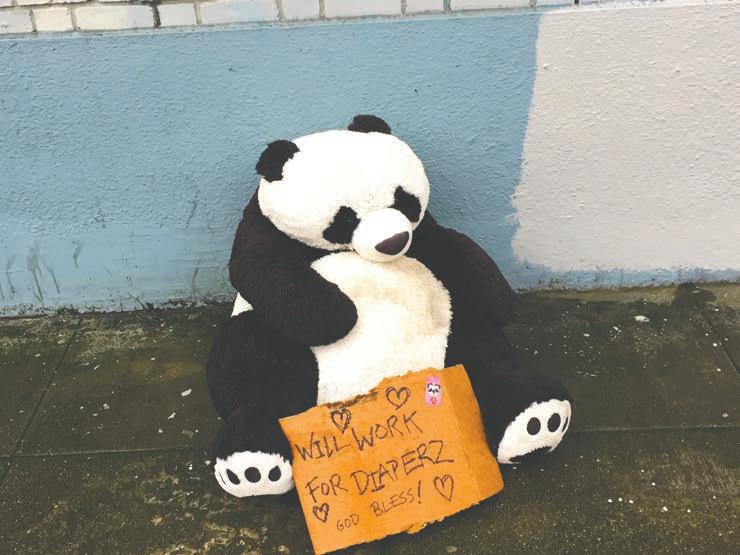Pg. 4 Lyft Creating Traffic Problems on Kansas Street Pg. 8

PHDC Education Scholarships Available to Potrero Hill Residents Pg. 17
Trump-Branded Products Pg. 6 INSIDE Gold Pg. 25


Pg. 4 Lyft Creating Traffic Problems on Kansas Street Pg. 8

PHDC Education Scholarships Available to Potrero Hill Residents Pg. 17
Trump-Branded Products Pg. 6 INSIDE Gold Pg. 25

The Good Samaritan Family Resource Center, on Potrero Avenue, has been a welcoming space for immigrants for 123 years. So, when Immigration and Customs Enforcement (ICE) agents showed up one morning while preschool and English-as-a-Second Language classes were in session it sent shock waves through the community.
It was January 26, one day after Donald Trump issued an executive order threatening to halt federal funds for sanctuary cities. Just hours later, Mayor Ed Lee, in his annual State of the City address, had doubled down on his support for maintaining San Francisco’s status as one.
“It was the next morning, shortly before 9 a.m., they show up,” said the center’s executive director Maria Paz, who wasn’t subtle about suggesting a connection in the timeline. “It reminded us of the new reality.”
Five ICE agents entered the building’s lobby, at least one armed with a gun and others with batons, searching for a sex offender slated for deportation they believed lived there. The agents were informed that the building wasn’t a residence, and were redirected to an affordable housing development further down the block. After congregating outside that apartment building for 10 minutes, they left without making an arrest.
ICE later admitted its agents had an incorrect address. The agency also informed the View that, as of press time, they hadn’t yet apprehended the suspect. Although ICE maintains a wanted list on its website, in this case, due to the nature of the ongoing investigation, the suspect’s name is being withheld.
San Francisco International High School Moving to Enola Maxwell CampusBY JACOB BOURNE
San Francisco International High School has been located at 1050 York Street for six of its eight-year history. The campus previously housed Bryant Elementary School, now at 2641 25th Street. Thought the facility was renovated to better serve teenagers, SFIHS’ population has doubled, from roughly 200 to more than 400 students, squeezing space for academic and extracurricular activities. This summer the school will settle into a new home: the Enola Maxwell campus, at 655 De Haro Street.
According to Julia Kessler, who’s been SFIHS’ principal at the York Street location, the student population is equivalent to other San Francisco Public School District secondary schools, like John O’Connell High School on Folsom Street, with only one-third the amount of space.
SFIHS’ student body consists of
HIGH SCHOOL continues on page 11

San Francisco International School multipurpose room.
PHOTO: Jacob Bourne
Spending Continues Long After Political Campaigns End
BY MICHAEL IACUESSA
O ffice parties, conferences, and donations to civic organizations are among the ways local politicians use campaign funds leftover after an election. The bulk of the remaining money, however, usually goes to paying political consultants.
dural in nature, including bookkeeping errors or failure to handle or deposit donations properly or promptly. Still, according to Stern, “There are a few who take advantage.”
One of the keys to understanding the law is differentiating between “surplus” funds, a legal definition, and excess money left-over. “Surplus funds means any money remaining in the candidate’s bank account at the time the candidate leaves elective office or after the defeat of the candidate,” explained Shaista Shaikh, assistant deputy director of the San Francisco Ethics Commission.
They also can be donated to the City and County of San Francisco, Shaikh said, “This is one I haven’t seen.”
Stern, an advocate for political transparency, believes the Act has held up well in 43 years. A search of the state’s Fair Political Practices Commission database shows only a handful of expenditure-related violations in recent years, most of which are proce -In the case of a defeat, funds aren’t designated as surplus until the first expenditure report is filed after the election. Such accounts, detailing donations and spending, have to be filed semi-annually; June 30 would be the latest allowable date after an election. State law is identical, other than adding an extra 90 days after that reporting period. Financial books can remain open indefinitely, but upon closure must have a zero balance.
Once deemed “surplus,” state law prohibits funds from being rolled over into a subsequent election, something a candidate who continues to hold office is allowed to do. Office holders, under City law, can use excess assets for expenses associated with their positions, provided the expenditures are for legislative, governmental or political purposes. Monies can’t be expended to support ballot measures or other candidates unless they’re involved in a ranked choice election. In
Urban Dictionary defines being “on the spectrum” as “a phrase used to describe a person with social tics and/ or awkwardness, usually associated with autism or Asperger’s syndrome.” As in,
“That kid seems a little off to me.”
“Yeah, totally; I think he’s on the spectrum.”
In a colloquial sense, being on the spectrum is a know-it-when-I-see-it phenomenon, a shorthand way to explain odd behavior as an unavoidable mental health characteristic. Yet based on the National Institute of Mental Health’s definition of “Autism spectrum disorder,” we’re all on the spectrum. Certainly I am. According to NIMH, “people with ASD often have these characteristics: ongoing social problems that include difficulty communicating and interacting with others, repetitive behaviors, as well as limited interests or activities…symptoms that hurt the individual’s ability to function socially, at school or work, or other areas of life.”
Let’s take these features in turn.
First, “Ongoing social problems that include difficulty communicating and interacting with others.” How many of us dread going to social gatherings – including with our own families – because of the need to make small talk or create conversations over an abyss of misunderstandings, mix of preferences, and varied personal histories? How often do any of us try to communicate, or interact, with people outside our own affinity groups, or across income class, race, or political parties?
Sure, we can all have a great time at a dinner party where the conversation is limited to well-trod topics: the high price of San Francisco real estate; the unfortunate need to step over homeless people on the way to work; oye, the traffic! But what happens if someone tries to talk about their challenges getting by on the minimum wage, how great Trump is, or the fact
that their ancestors were slaughtered by the U.S. Calvary? These topics may be fine conceptually, but uncomfortable if they’re pursued by people who are actually poor, live in Tulare County, or are Native American, in which case, most of us don’t know them, or at least don’t invite them over to dinner.
Second, there’s “repetitive behaviors, as well as limited interests or activities.” I don’t know about you, but 90 percent of my day focuses on the same dozen behaviors or activities, including brushing my teeth, making coffee, shaving, sitting in front of a computer typing, reading, eating, and playing with my iPhone. Even at my most expansive there is way more things I don’t do then do, some of which are coins of the realm for many people, liking watching football on television, enjoying popular music, or Snapchatting.
Then there’s “symptoms that hurt the individual’s ability to function socially, at school or work, or other areas of life.” The key word here seems to be “hurt,” as in can’t get along with bosses, ever. Has trouble dating successfully. Finds school to be tedious and annoying. Anybody experience these things? Everybody?
This isn’t to diminish the quite real challenges with which individuals with autism have to grapple. Some of us have brains that’re wired in such a way as to make “normal” communication extra difficult, or even impossible, creating a disability that significantly threatens lifelong prospects. But, apart from these persons, being on the spectrum has become a national disorder. Those of us who dislike Trump cannot understand, or even communicate effectively with, those who support him. Same for Kardashian lovers, or Fox news junkies, while on the other end of the spectrum to many of us National Public Radio is leftwing propaganda, especially The World and Democracy
PUBLISHER’S VIEW continues on page 12

Last month, the California Supreme Court removed the last legal barrier to a long-planned Muni streetcar ring in Dogpatch, rejecting an appeal by the Committee for Re-Evaluation of the T-Line Loop, which wanted the tracks redirected. The loop will run along 18th, 19th, and Illinois streets, and provide a link to the Central Subway, which is supposed to open in 2019. Construction is expected to begin this summer. The Committee is concerned that the loop will cause noise and traffic congestion, and has maintained that it would have been less disruptive if it was rerouted roughly six blocks to Muni’s Woods Yard Park. “Despite acknowledging lots of significant changes in Mission Bay and Dogpatch, Muni never went back and did review that the law ordinarily requires, said David Lanferman, the Committee’s lawyer.
In March, the San Francisco Planning Commission heard legislation advanced by Mayor Ed Lee and District 9 Supervisor Hillary Ronen to upzone Urban Mixed Use parcels throughout the Eastern Neighborhoods. The bill was part of a package of zoning changes to support the Mission Action Plan 2020 , including increasing height limits for UMU-zoned buildings in the Mission, with heights raised from 40 to 48 feet on a number of parcels in Potrero Hill and Dogpatch as well. The legislation characterized the bump-up as a “correction” to zoned heights “inadvertently” put in place during the Eastern Neighborhoods Planning process. District 10 Supervisor Malia Cohen indicated her support for Mission Action Plan goals, but opposed including the Hill and Dogpatch in the legislation, in part on the basis that, unlike in the Mission, there’s no PDR replacement requirement in those neighborhoods, and, as a result, the height increases wouldn’t provide additional protection for those types of businesses. In response, the Planning Commission exempted Dogpatch and the Hill from the proposed policy, which will likely be voted on by the Board of Supervisors this month.
$3.8 million renovation. It now features a state-of-the-art children’s play area, accessible walkway, natural lawn, and new landscaping. Newfangled park furniture has been installed and stormwater and irrigation systems upgraded. The park is encircled by South Park Street, running from Second to Third streets, with numerous cafes and restaurants along the road. The makeover was funded by 2012 and 2008 park bonds, as well as Eastern Neighborhoods Impact Fees, voter-supported Proposition K funds – through the San Francisco County Transportation Authority – lease revenue bonds, and a generous donation from the South Park Improvement Association. Dogpatchbased Fletcher Studio designed the space.
Last month, within days after abruptly announcing its closure, Speakeasy Ales & Lagers reversed taps, with a spokesperson stating that the company “…is working hard to maintain a future for their San Francisco brewery after agreeing to enter receivership on March 13, 2017. The company’s tap room will remain closed, but the brewery continues to produce your favorite beers, in addition to the all-new Murky Business APA.”
A sale to an as-yet-unnamed new owner is “anticipated to close during the next 45 days.” The 1997-founded brewer employs 40 people and sends its beers, like Big Daddy IPA and Payback Porter, all over the region, with 30 West Coast distributors. Its tasting room at 1195 Evans Avenue opened in 2011. In 2015, Speakeasy expanded to a new, larger facility capable of brewing 90,000 barrels per year. According to Inside Scoop, the majority of the brewery’s employees have been laid off; a “skeleton crew” of just six employees will keep production flowing.

Last month, South Park, San Francisco’s oldest park, reopened after a

The San Francisco Superior Court is accepting applications for Civil Grand Jury service for the 2017-18 term. “San Franciscans who are eager to make a difference and want to be an agent of change in this great City should apply to become a member of the Civil Grand Jury,” said Judge Susan M. Breall, who chairs the Court’s Civil Grand Jury Committee. “The Civil Grand Jury offers a unique and exciting opportunity to contribute to our community by examining City government to address inefficiencies in operations and hold officials accountable. This is an exceptional way to become involved in City affairs.” The submission deadline is May 31, 2017. Volunteers must be U.S. citizens; at least 18 years of age; lived in San Francisco for at the past 12 months or more; have no felony convictions; and be able to effectively communicate in English. Applications and more detailed information are available at http://civilgrandjury.sfgov.org/
Last month’s The Potrero View’s coverage of Forest City’s Pier 70 “Mega Project” extolled the many benefits of the 28-acre development, with little consideration of its negative impacts. Contrary to what was reported, the Draft Environmental Impact Report (EIR) identified nine “significant and unavoidable” impacts.
A massive increase in Dogpatch’s population, along with large numbers of workers, will overburden service on
the 22-Fillmore and 48-Quintara, with no funding identified for increased operation costs. “Substantial” noise and construction emissions during the anticipated 11-year building phase would pose risks to public health. Of grave concern is the permanent “cumulatively considerable net increase in air pollutants” in the surrounding communities from increased traffic.
The number of residential units developed at Pier 70 would potentially
PIER 70 continues on page 12
Development plans for Pier 70 call for five apartment buildings, six stories or taller, to surround the last piece of historic Irish Hill, a rocky outcrop backed by tall eucalyptus trees, easily seen from Illinois Street between 20th and 22nd streets. If those designs are realized, Irish Hill would be only partially seen through
openings between the structures from Illinois, 21st – a proposed street – and 22nd streets. An anticipated “Irish Hill Playground” in the courtyard formed by the edifices would be shady much of the year, with the main vantage point of Irish Hill from the roofs of two proposed buildings, looking down on the Hill from structures twice its height.
Irish Hill was once ten city blocks in size, home to a scrappy working

Editor,
Thank you, The Potrero View, for publishing a mix of viewpoints on the Pier 70 redevelopment project. Potrero Hill residents deserve to know the degree to which their views will be obstructed, as well as the demands Pier 70 will place on already overtaxed infrastructure.
The articles create an opportunity to have a more informed dialogue. Following my February op-ed on Pier 70 project impacts, Forrest City representatives asked to meet, offering visual simulations, some of which were published in the March View. We met at the Potrero Library, and admired the spectacular Potrero vistas.
Former Mayor Art Agnos, the author of March’s op-ed, stated that he didn’t accept consulting fees from developers in San Francisco. I sincerely believe he didn’t accept monies, and recognize that he’s identifying the individuality of his political conscience. Financial gain is, of course, the primary objective of any developer. That’s why it’s important to check facts yourself.
One fact test is transparency. The Planning Department made a conscious decision to remove visual impacts from the project’s environmental impact review. The intentional removal of this safeguard is the first sign that accurate public information isn’t a City concern.
Another fact test is responsiveness to concerns. Forest City performed limited visual impact analyses after my
op-ed, and declined to run additional simulations relevant to Hill residents. The cost of running visual simulations is negligible on a project of this magnitude; there’s no reason for Forrest City to decline doing so.
A final test of fact is the integrity

of information provided by proponents. The simulation published with the March op-ed is from a nearly unimpacted vista; the new buildings are pictured as light gray structures. I erred by not asking Forest City if the simulations were performed using engineering models at planned ground elevations. One has to anticipate that visual impact studies are likely to be minimized by proponents.
I generated several simulations
LETTERS continues on page 7




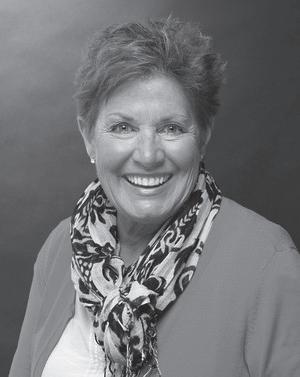
Following the November election and inauguration of President Donald Trump, national nonprofit organizations, like the American Civil Liberties Union, Planned Parenthood, Sierra Club and Anti-Defamation League, reportedly experienced a dramatic boost in donations in response to potential threats to civil rights, healthcare access and the environment from the new Administration. According to BBC News, the surge in giving has been so great that the ACLU recently partnered with Silicon Valley venture funding company, Y Combinator, to plan a strategy for the best use of the donations.
As the ACLU fights for civil rights with an annual budget exceeding $100 million, many small and locally-based nonprofits struggle with financial uncertainty. The political shift on the national level is still fresh, and the first fiscal quarter isn’t generally a telltale in terms of charitable giving. Still, some groups are preparing for possible leaner times.
“I do think people are probably starting to reach out to larger organizations that address housing, healthcare and women’s issues,” said Genevieve Leighton-Armah, administrative assistant, BAYCAT. “The arts are often seen as secondary to those other issues. People may start to prioritize these other issues over the arts in terms of giving.”
BAYCAT, located near Third and 20th streets, works with youth to create digital media projects. According to Leighton-Armah, the nonprofit typically spends the beginning of the year refining its community outreach efforts, to offer its studio and arts services to more youth. So far there hasn’t been a noticeable change in the flow of donations compared to last year.


“Claudia

Alexandra Morgan, chief executive officer of Family House, at 540 Mission Bay Boulevard, attributes the steady influx of donations to her organization to San Francisco’s wealth, and having strong relationships with longstanding patrons. However, since the organization moved from the Sunset to Mission Bay last May, its annual budget increased from $2.8 million to $3.8 million so as to serve more families, creating a need for more contributions. Family House provides temporary housing to families with children receiving care for serious conditions at University of California, San Francisco Benioff Children’s Hospital.
“Our need is great,” Morgan expressed. “We used to only serve 34 families, and now we can serve 80 families and are full every night. We’re in the process of asking our current and prospective donors for more funds. It’s going to have to be a more consistent and ongoing effort. We’re really in the position of needing to ask for more.”
A concern for some nonprofit leaders is that the Trump Administration’s promised tax code overhaul could include stricter limits on the amount of donations people are able to deduct on their tax returns. According to a February 24 article in wealthmanagement.com , more than 80 percent of Americans donate to charities every year. In 2013, 36.4 million taxpayers reported contributions totaling $194 billion.
Norman Gershenz, director of Savenature.org, a national wildlife advocacy group based at 699 Mississippi Street, believes that if someone wants to give to a certain cause, they’ll do so no matter the tax situation. However, he said potential new restrictions could have broad negative impacts. “Those tax code changes wouldn’t be good,” Gershenz said. “But when people are


giving from the heart, especially for smaller amount donations, it’s not as relevant from a tax standpoint. People give because they want to give. It may have an impact for some donors but not for everyone.”
Gershenz views the recent stream of donations to the ACLU and Planned Parenthood as a sign that people are concerned about politics and understand that certain organizations may be impacted by policy changes more than others. He said that there’s no way to determine whether funds are being shifted from one place to another; donations to Savenature.org haven’t noticeably changed. “Smaller organizations always have to hustle no matter what; whether Democrats or Republicans are in office,” he added. “We have to be vigilant, resilient and energetic to create new avenues for funding.”
Jeff Thomas, executive director of San Francisco Center for the Book, had heard reports of nonprofits being concerned about diminished donations due to diversion to groups like ACLU, but his organization actually did better following a fall fundraising drive than the prior year.
The Wildlife Conservation Network, with headquarters at 209 Mississippi Street, does most of its work internationally, and may not be as directly affected by domestic changes. However, the nonprofit’s executive
director, Jean-Gaël Collomb, said that a few donors announced that they’d be contributing elsewhere following the election, without offering specific reasons. “We’ve been bracing for the worst but don’t know yet,” he commented. “So far, the stock market and economy are doing well, which usually fairs well for us in terms of donations. I try to be optimistic and hope that people will give more across the board.”
If people are giving more across the board, it hasn’t yet filled the coffers at the Potrero Hill Neighborhood House. The nearly 100-year-old organization geared towards youth-oriented programming and education has been struggling over the past five years, according to Edward Hatter, executive director.
“I wish I could blame it on Trump this time,” Hatter remarked in jest. “Individual grants have been pretty level compared to this time last year, meaning that giving has been low. The community changes so much, and it takes time to do outreach and get people invested in the work that we do. There has been a trend in San Francisco in terms of the City funneling corporate money to larger organizations, like the YMCA, and a lot of smaller organizations have suffered. The City is only now starting to look at strengthening some of the smaller, older, organizations against this competitive market.”
In 2007, the Port of San Francisco issued a request for proposals for the development of Seawall Lot 337 and Pier 48 in Mission Bay, which currently serve as a surface parking lot. The site is just south of AT&T Park, the South Beach home of the San Francisco Giants. The baseball team immediately responded with a bid to develop the 28-acre property, now called “Mission Rock.”
“Ever since the building of the ballpark at the waterfront, we’ve been deeply rooted in the community and have been committed to working with the neighborhood,” said Fran Weld, vice president of strategy and development, San Francisco Giants. “We want to make sure that the site functions logically and is part of the greater vision for Mission Bay.”
In 2013, the Port entered into an exclusive negotiation agreement with Seawall Lott 337 Associates, LLC, a Giants affiliate. Project specifics are still being defined. Current plans call for 1,500 apartment units, 1.3 million square feet of office space spread across five buildings, 250,000 square feet of ground floor retail in several buildings, and eight acres of publicly accessible open space. Forty percent of the units will be designated affordable for low- and middle-income residents. The rental housing will range from studios
to three bedrooms, the latter to help address a dearth of family-oriented homes in Mission Bay.
Much of the retail services will involve businesses that cater to those who live and/or work nearby. Space will be set aside for community-based organizations and production facilities, such as artists’ and makers’ studios. Some housing will be dedicated to youth transitioning out of the foster care system because they’ve reached the age of 18. The developer is working with the John Burton Foundation, a San Francisco-based group that focuses on foster care issues, to implement this element.
“It’s a busy time for the project,” said Phil Williamson, senior project manager, Port of San Francisco. “The project is in the entitlement phase, which may be wrapped up this year. The planning has been going on for 12 years. It’s been a long evolution.”
The environmental review process is underway, with a draft EIR to be released this month. The project requires approval by the Planning and Port commissions and the Board of Supervisors. If approved, a four-phase buildout would commence next year and could continue until 2025.
The project cleared a hurdle in the November 2015 election, when Proposition D passed with 74 percent
In January 2019, District 10 Supervisor Malia Cohen will be termed out of office. She was first elected in 2010 to represent a large swath of San Francisco’s Southside neighborhoods, including Potrero Hill, Dogpatch, Bayview-Hunters Point and Visitacion Valley. This year has brought a shift in focus to the Board of Supervisors, with a new Administration in the White House that’s challenged San Francisco’s status as a sanctuary city, one that doesn’t use its resources to enforce federal immigration laws, among other tests.
The new year has also brought change to Cohen’s role on the Board. Most notably, she’s now chairs the Budget and Finance Committee, leaving behind her former post as chair of the Land Use Committee. Budget and Finance had been led by District 2 Supervisor Mark Farrell, who has taken over Cohen’s role on the Land Use Committee.
“The Chairman of the Budget and Finance Committee is a heavy task for any Supervisor, and should keep her busy between now and July,” said Jim Lazarus, senior vice president of public policy, San Francisco Chamber of Commerce. “There’s a projected budget deficit for the 2017 to 2018 fiscal year, so she will have her hands full. She looks after District 10 and as chair the District can look forward to some positive outcomes.”
Don Clark, Missouri Street resident, pointed to a number of issues facing the neighborhood that he hoped Cohen would tackle, including property crime and unreliable public transit. However, Clark believes that the City’s “run-away budget” should be her highest priority. “When one considers the magnitude of the San Francisco budget,
it seems like all the aforementioned problems should have been solved,” he commented. “The City increases spending by astonishing amounts each year, with no visible improvements in public service. This budget growth has to be severely detrimental to cost of living for everyone.”
With many largescale developments in the planning pipeline for the eastern neighborhoods and southern Bayfront, including The Shipyard in Bayview-Hunters Point, Mission Rock, Pier 70, and Golden State Warriors arena, Southside residents were surprised by Cohen’s departure from the Land Use Committee. Land Use Committee members Farrell, District 3 Supervisor Aaron Peskin and District 4 Supervisor Katy Tang have a more limited stake in the ongoing dramatic transformation of development and demographics in District 10.
The View was unable to secure an interview with Cohen to ask her why she made the shift. The supervisor has generally declined to speak with the paper throughout her time in office.
“I think she’s going to get more involved in land use because of all the projects that are happening on this side of the City and along the waterfront,” offered De Haro Street resident Ron Miguel. “With UCSF’s development and student housing, neighbors are concerned about expansions out of the Mission Bay campus and into the neighborhood.”
“The one consolation is that she’s accepted the chairmanship of the most powerful position on the Board of Supervisors,” said Art Agnos, former Mayor and Connecticut Street resident. “Every City department pays attention to the Budget chair. If you’re going to give up chairmanship of the Land Use Committee, the only one you’d want to give it up for is the Budget chair.”

Dogpatch and Potrero Hill residents have expressed concerns about the University of California, San Francisco’s acquisition of neighborhood properties outside Mission Bay, citing poor building designs that depart from the existing neighborhood character and noting that as a state agency the University is exempt from paying impact fees and property taxes. According to Tony Kelly, Potrero Hill Democratic Club president, Cohen’s office has been supportive of neighbors during protests and negotiations with UCSF, by attending meetings and commissioning a study by the Board’s Budget and Legislative Analyst that analyzed impact fee and property tax revenue losses when the University develops private property.
“That study showed that, in effect, our neighborhoods and the City are subsidizing UC’s development on three sites in Dogpatch by more than $100 million over the next 30 years,” Kelly stated. “It’s an important point in our negotiations; we won’t get all of that value back from UC, but we may get a stronger array of benefits than they expected to give. We could not have done that kind of research without the support of the Supervisor’s Office.”
Alison Heath, Mississippi Street resident and leader with Grow Potrero Responsibly, encouraged Cohen to focus on ensuring that the community benefits promised in the Eastern Neighborhoods Plan are delivered, and to spearhead new transit routes and public open space areas. “The City has overbuilt market-rate housing in our neighborhoods, and the pace of infrastructure development is lagging,” Heath commented. “Unfortunately, the impact fees paid by developers to fund improvements were set artificially low. New means of financing should be identified, and I’d like to see the Supervisor prioritize that effort.”
On March 3, the San Francisco Examiner suggested that Cohen’s move to the Budget and Finance Committee could aid her aspirations to run for a spot on the California State Board of Equalization. Fiona Ma currently holds the seat. Rich Gordon, who served in California’s State Assembly from 2010
to 2016, representing the 24th District, plans to vie for the position. According to Secretary of State records, Cohen filed to run for a State Board of Equalization seat in February.
“She’s a viable and worthy candidate for the State Board of Equalizations, just as she was a worthy candidate for two elections to the Board of Supervisors,” remarked Agnos.
Susan Eslick, Tennessee Street resident and GBD board member, thinks that national politics have diverted attention away from local issues. Eslick hopes that the City’s mental health crisis will be prioritized by the Board of Supervisors, and that Cohen will be mindful about issues that may arise in Dogpatch from the Navigation Center, a newly opened homeless shelter. “She needs to be a liaison for us,” Eslick said. “Dogpatch was generous in accepting the Center, so she has to support us. She’s been at the table for our community, so I’m sure she will continue.”
The Examiner reported that the Supervisor delayed the City’s application for homeland security grants associated with Urban Shield, an anti-terrorism force, amidst civil rights concerns. Urban Shield is a SWAT training program that some say creates a militarized police force, with increased concern prompted amidst the Trump Administration’s targeting of undocumented immigrants.
Last month, the Board of Supervisors passed an ordinance, co-sponsored by Cohen and Mayor Ed Lee, prohibiting local officials from communicating information about the religion or ethnicity of San Franciscans to federal authorities. The law is a proactive measure against the possibility of cooperating with President Trump’s proposed and controversial Muslim registry.
“The influence of national politics is that it can bring people together,” said Lazarus. “San Francisco politicians are mostly Democrats, and if San Francisco is targeted by the White House, then it helps maintain a level of collegiality. The major issues coming out of Washington make local disagreements seems somewhat trite by comparison.”
Potrero Hill residents who believe they’ve detected an increase in crime in the neighborhood appear to be right. According to information provided by the San Francisco Police Department’s Bayview District, which includes the Hill, vehicle theft jumped from 6,126 offenses in 2014 to 6,915 in 2015. There were 19,827 cases of objects getting stolen from a vehicle in the area in 2014, compared with 25,899 instances in 2015. SFPD was unable to provide data for 2016.
Hill resident and software engineer Peter Flynn was on Rhode Island and 18th streets in late February when three men ran up to him, pointed a gun at his head, and demanded his bag, which contained two laptops. “I’ve lived in my same place in Potrero for about ten years, uneventfully almost the whole time, and in the last couple of years, I’ve experienced a big uptake of crime,” Flynn said.
In addition to the robbery, Flynn’s car was stolen from in front of his 18th Street apartment “a couple of years ago,” and the vehicle was broken into last fall. “I don’t want to over-generalize from anecdotes, but for me at least, the experiences really changed in the past couple of years,” Flynn stated.
A Hill resident who wished to be identified as “Max,” who has lived in the neighborhood since 2015, woke up one morning last summer to see his car, which was parked outside his Rhode Island Street house, near Whole Foods, with all the doors open, though nothing had been taken but a few receipts. According to Max, there are “weekly car break-ins,” but he hadn’t heard of many armed muggings. “The general expectation now is that you’re going
to get your car broken into,” Max said. “It’s going to happen like once or twice a week.”
Pedro Ceja, an electrician, who has lived on the Hill for seven years, said that he’d been the victim of several car robberies over the past couple of years. Ceja said he caught someone trying to break into his car last month; one of his vehicles was stolen from in front of his Hill home on 18th and San Bruno streets last year. He was able to recover it, but several days later someone attempted to steal it again from the same spot. Tools and a laptop were taken from his vehicle twice over the past 18 months.
In February, Ceja’s girlfriend, Monica Kicklighter, who has lived with Ceja on the Hill for almost three years, was awakened at 2 a.m. by the sound of someone breaking into her car. She said Ceja and her father were able to detain the criminal until the police came. “Potrero is still one of the safest neighborhoods in the City, I think, so even though this is scary, and I got unlucky, most people aren’t going to have to experience this,” Flynn said. “People (should) be a little more aware. Taking those extra precautions really can make a difference.”
According to Officer Patrick McNichol, who was recently assigned “beat cop” duties on the Hill, SFPD is fielding more plainclothes constables in an effort to stop car break-ins. More than 70 vehicles are subject to theft in San Francisco a day.
Flynn urged people to watch out for their safety and their belongings. Although it “sucks to lose that stuff,” he said, “it’s just stuff.”
The Potrero Hill Democratic Club (PHDC), a chapter of the San Francisco Democratic Party, is informally encouraging a boycott of San Francisco Bay Area stores that carry Trumpbranded products. According to Robert Boileau, PHDC’s first vice president, club members are concerned that Donald J. Trump and members of his family are profiting from the presidency.
“I believe the presidency should not be enriching him or his businesses. I realize it’s kind of hard when your name is your brand. Yet I think they should make an effort to divest. This is a good way to get them to divest,” said Boileau.
Boileau said the boycott idea first emerged at a January 2017 executive committee meeting. “We then brought it up at the next general meeting. Many people…were saying their conscience wouldn’t let them buy Trump goods. We put it up to our members. Then we gave them an info sheet from the Grab Your Wallet campaign,” he said.
Grab Your Wallet, founded by Bay Area residents Shannon Coulter and Sue Atencio, identifies a long list of stores that carry Trump-branded goods, including Marshall’s and TJ Maxx – owned by TJX Companies – Saks 5th Avenue Off 5th and Lord
& Taylor – owned by Hudson’s Bay Company – and Bloomingdale’s and Macy’s, which are owned by Macy’s.
The list used to include Nordstrom’s, until that company dropped Ivanka Trump-branded products last winter. Grab Your Wallet’s catalogue is continually changing, as retailers take on or abandon Trump-branded products.
“We have 80 to 100 members in the PHDC, and over 50 people at an average meeting,” Tony Kelly, PHDC president said, though he doesn’t know how many members are engaging in the boycott. “We don’t have to vote on it to do it. It really is much more of a do-ocracy than a democracy,” he said.
“…we made this decision based on performance,” Nordstrom’s stated. “Over the past year, and particularly in the last half of 2016, sales of the [Ivanka Trump] brand have steadily declined to the point where it didn’t make good business sense for us to continue with the line for now. We’ve had a great relationship with the Ivanka Trump team. We’ve had open conversations with them over the past year to share what we’ve seen and Ivanka was personally informed of our decision in early January.”
According to Cindy Wu, San Fran-
BOYCOTT continues on page 7



LETTERS from
page
which demonstrate the sensitivity to ground level height, building color and viewing elevation. The project will
The Bay is severely obscured in my simulation. A large number of Potrero residents living at elevations between 130 and 170 feet will lose their Bay views; views from public areas will also be eliminated. A structure that works


increase ground height to a minimum of 15 feet above sea level; the roofs of 90 foot buildings will be at least 105 feet above the water. Some rooftops will be 130 feet above sea level. Two of the closet structures to the Bay will be 105 feet above sea level, roughly aligned with the Potrero Power Plant’s steel structure.
Viewing Pier 70 from near 22nd Street I’ve simulated impacts at a 155-foot view height using photoshop. These simulations reference the steel structure’s height, and represent views that one might see from their homes. To be sure, my photoshop studies aren’t as accurate as quality engineering simulations.
BOYCOTT from page 6
as a blockade effectively makes Bay views exclusive to those able to afford them, taking views from all of us.
While Forest City is proposing attractive aesthetic treatments, a project of this size will have the mass of a shopping megamall. The photo to the right, of a Berlin housing project, is just slighter taller, with similar massing and density, to proposed Pier 70 buildings. Buildings like this have already been erected along Mission Bay, though at two-thirds the height, and in pockets of Potrero. No amount of embellishment can hide megastructures.
The author advocates that impact fees and development taxes be used effectively to address these issues. This point is well taken. San Francisco was rated fourth worst in the globe out of 1,064 cites for traffic congestion in 2016. Average annual traffic delays increased from 75 hours in 2015 to 82 hours in 2016.
Agnos effectively presided over San Francisco with a $1.2 billion budget, and led the City through Loma Prieta earthquake recovery. San Francisco now operates at a deficit, with a $9 billion budget. Former Mayor Agnos demolished one massive transitinspired visual monstrosity and gave us back the Embarcadero waterfront. Imagine 90 foot structures next to the Ferry Building or directly in front of it.
the impacts. Our waterfront parks should celebrate Bay views for all residents, instead of creating exclusive new views for a few. I hope that Forest City will support a more complete analysis.
Shouldn’t we ask the City to demonstrably fix transit issues before compounding an already grossly overloaded public transit corridor, triggering substantial increases in automobile traffic and consequent greenhouse gases?
The City doesn’t have to mandate new high-density housing projects to build new waterfront parks, public spaces and artist enclaves. There are other solutions, such as construction that respects historic heights and facades, and fixing transportation infrastructure before massively increasing

Typically, the Embarcadero waterfront has 400 foot setbacks for skyscrapers, as opposed to the planned 40 foot setbacks in the Pier 70 project.
Shouldn’t we expect Forrest City to run simulations for any potentially impacted resident? Don’t Hill residents deserve to know the degree to which their views will be obstructed? I sincerely hope my simulations overstate
vehicle traffic. We shouldn’t be forced to choose between high density housing projects or no new public spaces.
Don Clark Missouri Streetthe boycott. “We are supportive of any effort any club makes. I think the work that the PHDC is doing is standing in line with democratic values,” she said.
“Obviously, the Republican Party

is against it,” Howard Epstein, vice chair of communications for the San Francisco Republican Party (SFGOP), said. “They are acting like sore losers. They lost the election fair and square. They’re coming up with the boycott, anything related to Trump. If they need to do something, they need to focus on the next election.”
According to Boileau, “polite conversation” discouraging stores from carrying Trump-branded products haven’t been persuasive. “There was some conversation at our March 7, 2017 meeting about…picketing these stores. The next step on this is to go to the presidents of the other Democratic clubs in town to see if they want to take
that step with us,” he said. Boileau said it’s challenging to keep track of which stores in the area merit being boycotted. “Bed Bath & Beyond only had one thing on the list, an Ivanka baby diaper bag. When I checked, they did not have that. The inventory varies from store to store in some cases. It’s not clear to me whether store managers have the power to set their inventory,” he said.
Joni Eisen, former PHDC president, said that while she supports the boycott, she doesn’t consider it “a major thing to be doing in terms of the resistance. It’s important not to be
BOYCOTT continues on page 26


When Lyft decided to open a place where its drivers could interact in person with company employees it seemed like a good idea. Drivers could get advice, questions answered and problems resolved by talking to someone face-to-face rather than resorting to email support. For the many out of town drivers, a physical location would also offer a place to use the bathroom and grab a cup of coffee.
However, it wasn’t long after Lyft opened what it calls “The Hub,” at the corner of Kansas and 26th streets, last fall that neighbors became alarmed at the increase in traffic.
Located on the site that used to be Bell Plumbing - the place with the van hovering on a stick over Highway 101 – South Slope Potrero Hill residents saw traffic rise from less than a dozen plumbing vans that operated several years ago, to at least 150 Lyft cars a day. The Hub parking lot holds 30 cars; most drivers park along the street, where they can get back on the road more quickly.
Increased traffic, with associated noise and pollution, are only some of Hill residents’ concerns. Neighbors also say many drivers behave badly; double-parking, making dangerous U-turns or littering.
“The first Saturday they opened up our block looked like a stadium,” said
Kansas Street resident Julie Drechsel, indicating that it’s not unusual to pick upwards of one-dozen coffee cups off the ground daily. “It’s a complete nuisance to have them on the block. It’s changed the dynamics of the neighborhood.”
Cesar Chavez, one of only three roads leading off Potrero Hill from the east side. In addition to traffic exiting the Hill, three bus lines turn at the intersection.
The east side of Kansas Street has perpendicular parking. Drechsel no longer parks in front of her house because she fears backing out. She alluded to an accident a few months ago, when a resident got hit pulling out of one of the spots. Though the other vehicle wasn’t connected to Lyft,
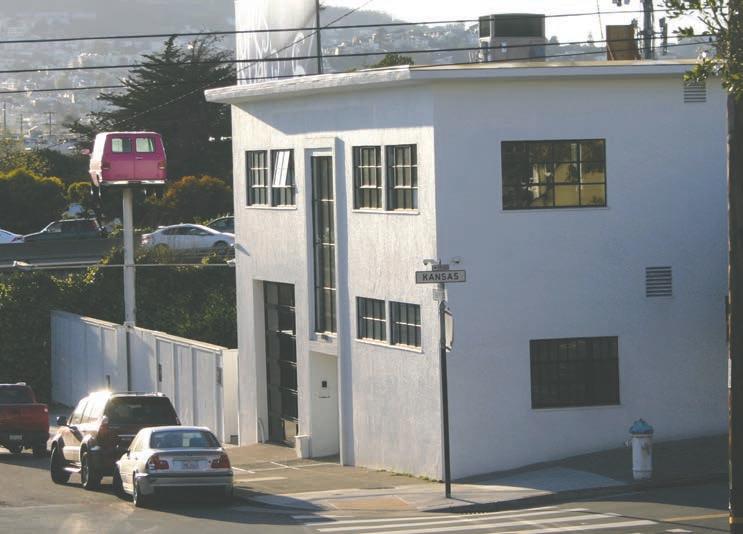
John Panelli, another Kansas Street resident, likened the daily commotion to living at San Francisco International Airport. “They are essentially using two blocks as their own parking lot.”
The Hub is located at a rounded corner where 26th Street feeds into
C��� �� ���� �� � ���������� ����� I�������� F���� C��������
ST. TERESA OF AVILA CATHOLIC CHURCH
PALM SUNDAY
APRIL 9
Saturday Vigil: 4:15pm, Palm Sunday, 8:30 & 10am
EASTER TRIDUUM
HOLY THURSDAY
APRIL 13: 7:30pm
GOOD FRIDAY
APRIL 14: 12:15pm
HOLY SATURDAY
APRIL 15
Easter Vigil: 8:00pm
EASTER SUNDAY
APRIL 16 8:30 & 10:00am

S����� �� ��� C��������� ���� ���� S����� �� C���������� P�����

Drechsel said a traffic jam ensued that backed angry honking drivers for several blocks.
In December, a witness called police to report a two-car accident in which both parties fled the scene, leaving a bumper in the road. Panelli recalled the incident involving three
cars, with one backing out, getting hit and being pushed it into another vehicle coming the opposite direction.
Lyft has responded by installing signs on the building’s exterior that hector drivers to use trash cans, not smoke in front of people’s houses and obey traffic laws. The company has also filed a request to have more Citymaintained trashcans installed in the area.
After distributing an email address for residents to report complaints, Lyft decided to appease neighbors by curbing The Hub’s hours. Originally open Saturdays and on weekdays from 10 a.m. to 7 p.m., it’s now only accessible Mondays through Fridays from 10 a.m. to 5 p.m. According to Mihir Gandhi, the facility’s general manager, the initial schedule was structured to accommodate drivers who work day jobs and drive for Lyft off hours. The site offers a lounge space, and employees offer assistance on a variety of issues, including how to setup direct deposit, deal with SFO compliance, and explain why a driver might have been deactivated. It’s the only San Francisco location where Lyft undertakes car inspections for new drivers.
Last month, Lyft held a meeting at The Hub for neighbors to air their concerns. Thirty people attended, including District 10 Supervisor Malia Cohen and representatives from the San Francisco Municipal Transportation Agency and Police Department.
Referring to the traffic situation as “pretty intense,” Bayview District Police Captain Raj Vaswani informed
With Phase 1 (Block X) underway, we have begun to turn our attention to Phase 2 of our rebuilding and transformation efforts.
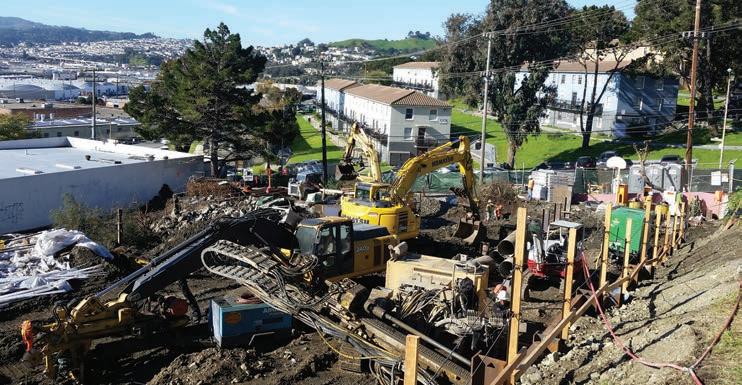
S����� ������
Saturday Vigil 4:15 pm
Sunday 8:30 am 10:00 am
������� ������
Tuesday 8:30 am
Friday 8:30 am
StTeresaSF.org
Phone: 415.285.5272
Email: info@stteresasf.org


 BY BRETT YATES
BY BRETT YATES
Besides its good coffee, Piccino Coffee Bar’s essential charm is that within the converted horse stables of Dogpatch’s iconic Yellow Building it occupies an alcove separate from its parent establishment – the upscale trattoria at 1001 Minnesota Street, with an around-the-corner entrance facing 22nd Street – which makes the tiny café, with seating for about six customers, feel – though internally connected – like a hidden and possibly rogue outpost, as if it were operated by Piccino employees without the knowledge of the larger restaurant’s owners or management. Yet the house-made pastries, like the ginger scone and the pain au chocolat, are prepared with the same craft and seriousness as Piccino’s thin-crust pizzas and elegant salads. The coffee bar stays open later, 10 p.m., than any of the neighborhood’s other cafes. The absence of wifi allows the small coffeehouse to retain an old-world vibe. It opens at 6:30 a.m. on weekdays; 7 a.m. on weekends.
If I’m free in the early afternoon one of my favorite things to do is head to the Street Soccer USA Park , at Terry A. Francois Boulevard and Third Street, across Mission Creek from the AT&T Park. An extension of the popup restaurant village known as The Yard – a sort of miniature preview of the development to come – Street Soccer USA offers daytime soccer seven days a week in an immaculate facility containing lockers, score -


boards, flood lights, a sound system, and two small, artificial-turf pitches.
The soccer fields at Mission Rock, each just 72 feet long, are made for four-on-four games, a kind of outdoor futsal with its own unique set of rules, including an inviolable goalie circle and a requirement that each team keep one player permanently on offense. It takes some getting used to, but it’s fun and friendly, and there are lots of opportunities to play, including weekday lunchtime pickup, Monday through Friday, 11:45 a.m.; drop-in tournaments on Tuesday and Friday nights, 6:30 and 8:00 p.m.; and Saturday and Sunday afternoons, noon to 1:30 p.m.. The nonmember pricing is steep, ranging from $10 to $15 per session, but a $50 monthly fee provides unlimited drop-in access.
Street Soccer USA – whose adult soccer programming generates funding for recreational opportunities aimed at underserved urban youth in 14 American cities – also offers organized league play.
In Greater Potrero Hill my favorite restaurant that isn’t open for dinner is Wolfe’s Lunch, 1220 16th Street, a longstanding workingman’s lunch counter that, despite its outward appearance as a classic American diner, with a menu of burgers, cheesesteaks, and BLTs, additionally functions as an authentic family-owned Asian restaurant on the side, serving Korean and Japanese dishes like donburi, bibimbap, and udon, starting at 6 a.m., closed Sundays. The eatery’s modest interior, which sits amid a
slightly forlorn stretch of blank-faced warehouses between the Hill and California College of the Arts, only adds to its appeal, and is reflected in the pricing, which doesn’t exceed $10 for any dish. The food is delicious.
Last month, the Museum of Craft and Design, 2569 Third Street, which may be as well-known in Dogpatch for its gift shop as for its programming, opened three new exhibitions which will run until June 4 and are worth visiting: Janice Arnold’s Felt DeCoded - Wool: Nature’s Technology; The wildLIFE Project by Wendy Maruyama; and Archive of Creative Culture, a multi-participant book collection representing major sources of inspiration for various artists and cultural figures. Arnold’s unabashedly, even humorously, enthusiastic tribute to wool and its variants embraces scientific, artistic, and historical perspectives to help visitors regain an appreciation for the genuine miracle of a common textile fiber. Using videos, touchable fabric squares, a science-class chalkboard diagram, and detailed timeline of early wool and felt production, the exhibition is both an educational lesson and an art experience. Arnold gathered artifacts that range from a 19th-century Hungarian shepherd’s cloak to a 1950s American poodle skirt, placing them alongside her own felt creations, which comprise objects practical and decorative.
If Arnold’s space is celebratory, Maruyama’s is mournful, addressing the plight of the endangered African elephant and the callous ivory trade
that began with the complete elimination of North Africa’s elephant population under the Roman Empire. Today, there’s only about half a million elephants left worldwide. Maruyama, a Japanese-American furniture maker, has used wood panels to construct a collection of six hauntingly faceless, wall-mounted elephant heads. Apart from these the spare exhibition features only a transparent case of severed glass tusks and a Buddhist shrine in which a bell chimes every fifteen minutes; roughly as often as a real-life elephant is poached.
The Museum of Craft and Design also currently houses a cool smaller installation, Mixed Messages , created last fall for a year-long run by Chris Eckert, an artist who, feeling overwhelmed by the pace, horror, and complexity of current events and politics, decided to build, with the help of John Green, 24 Morse code telegraph machines that tap out the Twitter feeds of news organizations like the BBC and Al Jazeera in real time. As the media’s unceasing flow of information is reduced to a cacophony of unintelligible clicking, the project metaphorically dramatizes what Eckert calls “the saturation point” of consumption within the 24-hour news cycle.
The museum closes at six, which makes the Hard Knox Café, 2526 Third Street, a sensible early dinner destination after a visit, as it requires only crossing the street. Its menu of filling soul food dishes – smothered pork chops, oxtails, chicken and waffles, and other Southern favorites, each of which comes with two sides and corn muffins – serves as an occasionally necessary counterpoint to San Francisco’s sometimes dainty food scene. You’ll be stuffed and, waddling out the door, probably ready to call it quits for the night.
Almanac Beer is a San Francisco company whose brews can be found in 20 states. Launched in 2011 by Jesse Friedman and Damian Fagan, the “gypsy” brewery – one that relies on other breweries’ equipment – started in Dogpatch, where its administrative offices are still found.
Friedman and Fagan began as homebrewers. For years in their respective City apartments the pair concocted five-gallon stovetop batches. They started selling at farmer’s markets, and settled on Third Street as the company’s home because they knew the area well. Friedman has lived in Potrero Hill for a decade; Fagan’s been a Mission resident on and off for the past 15 years.
“We wanted to be part of those diverse and exciting neighborhoods, so the location was a natural fit for us,” Fagan told the View
Friedman and Fagan brainstorm ideas for interesting, unusual, and seasonal beers. In addition to water, malt, yeast, and hops, Almanac beer includes fruit, though the pair avoid too sweet flavors. Once a recipe has been devised, Almanac selects a local partner farm to provide the produce. The company uses many different forms of citrus from Hamada Farms in Kingsburg; stone fruit, including plums, nectarines, and peaches, from Blossom Bluff Orchards in the Central Valley; and strawberries from Swanton Berry Farms in Santa Cruz.
For barrel-aged brews, the beer is racked into oak barrels and continues to evolve during a secondary fermentation. The beer absorbs hints of toasted vanilla and oak from the barrel, and fuses with fruits.
Almanac works with about 35 distributors across 20 states. In California, most boutique beer-wine-spirits stores stock Almanac products, as do larger beverage retailers like BevMo, Total Wine, Raleys, Nugget, and some Trader Joe’s stores. City Beer Store, Healthy Spirits, Blackwell Wines, Ales Unlimited, and Whole Foods Markets have Almanac on their shelves.
“We’re in many bars and restaurants as well; Toronado, Zeitgeist, Crafty Fox, The Willows, and Sycamore are all great beer bars that carry Almanac on draft,” Fagan said.
At the end of last year, Friedman and Fagan opened a taproom on 24th Street and Potrero Avenue. They don’t brew beer there – Almanac remains a gypsy brewery – but the taproom serves a selection of 15 Almanac draft beers and a constantly rotating set of bottled beers. It offers “fresh” beers too, such as ales, saisons, and IPAs. A full menu of seasonally-focused food, including a range of house-made charcuterie, is available.
“The taproom is all ages and we have a killer outdoor beer garden, which is so great to have in the sunny Mission,” Fagan said.
In terms of future plans, “exciting things” are in the works, but Fagan declined to divulge further details.

“I can’t share a whole lot more right now, but continuing to brew delicious and creative beers with high quality California-sourced ingredients is something that will always be at the core of what we do.”
GIANTS from page 4
in favor, allowing for building height limits on the property to be increased to 240 feet, while mandating the provision of open space, affordable housing, and Pier 48 historic preservation. Anchor Brewing will operate a satellite facility there. The development will make the waterfront site more resilient to sea level rise by adding salt tolerant plants on the shoreline and increasing the grade of the slope inland from the water’s edge.
“Sea level rise is something we’ve addressed on a fundamental level in the design and engineering of the project,” explained Weld. “The buildings will be able to accommodate up to 66 inches of sea level rise, which is the highest projection right now by the IPCC.”
Mission Rock is slated to be part of the City’s burgeoning Eco-District program, which encourages development projects to exceed City sustainability requirements. As part of the program, Mission Rock buildings will have zero water waste and 100 percent renewable energy.
The project may create more than 10,000 construction and 11,000 per-
manent jobs. The developer is working with the Port and City to hire san Francisco-based businesses for at least 20 percent of labor contracts. Development fees are expected to generate more than $100 million, with another $25 million collected in yearly taxes. The estimated cost to develop Mission Rock is $1.8 billion. Once completed it’s expected to generate significant revenue while increasing land values.
“I believe that Mission Rock, along with Forest City’s Pier 70, will be the model for future development in the City because of the commitment to community benefits that include affordability, open space and environmental improvements,” said Art Agnos, former Mayor and Connecticut Street resident. “Mission Rock will be the gold standard for developments to come throughout the City by setting a precedent for higher expectations when projects go to the Planning Commission or Board of Supervisors. It’ll be the gold standard for future sustainability and affordability.”

Housing, which owns it through a partnership with Good Samaritan. The visit prompted Mission Housing Executive Director Sam Moss to believe he needed to step up to the challenges immigrants now face in the Trump era. After consulting La Raza Centro Legal and the American Civil Liberties Union, Moss drafted a notice that now appears on all of Mission Housing’s 38 buildings. It instructs law enforcement that no one on the property is trained to read or interpret warrants, and that all requests for entry must be directed to Mission Housing’s main office on Valencia Street.
“I decided it was our duty to act as a gatekeeper to protect our 3,000 tenants,” he said. “Anything I can do to stop ICE from harassing immigrant communities, I am happy to do that. I don’t expect a desk clerk to stand up to them, but I will.”
Moss has been working with others in the Mission to establish a housing family resource fund to assist people with living costs in case a household income earner is detained or deported.
The preschool incident drew attention beyond the City’s borders.
ICE’s own policies ban actions at “sensitive” places, such as churches and schools. Reports that such enforcements were occurring, including one outside a church shelter and another at a courthouse where a female immigrant was seeking a restraining order against an alleged abuser, prompted state lawmakers to ask ICE to clarify their procedures. In February, leaders of the California Assembly and Senate filed a Freedom of Information Act request for data about ICE actions that took place from January 20 to February 20, including all written material, such as memorandums and emails.
At the time of the ICE visit, 30 children were attending preschool, with 20 adults in the ESL class. Paz said it was fortunate most were already in class and not in the lobby. Still, he said some people on their way to the center saw the officers, got scared, and left.
The center, which was founded in 1894 by the Episcopalian Church, has been located at 1294 Potrero Avenue since 1908, two years after the earthquake destroyed its original home at Second and Harrison streets. It was the City’s first settlement house, assisting an assortment of mostly Scotch, Irish, German and other Europeans.
In the 1970s and 1980s, an influx of Spanish speakers began arriving, fleeing civil wars and economic conditions in Central America. When the Loma Prieta earthquake required replacement of its old building in 1989, the nonprofit reformed, with a primary emphasis on Spanish language immigrants. The 20 affordable units on the block were constructed at the same time.
In addition to the preschool, the 13,000-square foot center hosts several classrooms, and a kitchen with a healthy eating program.
According to Paz, a San Francisco native born to El Salvadoran immigrants, 3,000 immigrants a year attend Good Sam’s classes. While 70 percent of those are children, the curriculum is multi-generational. With toddlers in preschool downstairs, parents can attend classes upstairs, some of which focus on parenting.
“Strong families are key to children being healthy, happy and productive,” Paz said. “With early literacy, we emphasize the importance of parents reading and talking to children so they can be exposed to vocabulary.” Last year, 86 percent of the center’s ESL students demonstrated gains in posttesting, far above the state average of 65 percent.
The center runs a variety of field trips for older children. One program teaches kids how to ride and fix bicycles. Five sports programs are offered in the summer, with sliding scale charges that usually average $30 per child. “We have families that can’t afford Park and Rec fees or the YMCA,” Paz noted.
The connection with predominantly poorer immigrants has given the center’s three dozen employees a keen view into gentrification in the Mission. Whereas in previously years most of the clients resided in the Mission or Potrero Hill, increasing numbers of students are coming from Hunters Point and the Tenderloin
“The immigrant community often comes from poverty, so it is more resilient, but there is a lot of hardship right now,” said Paz. “We are seeing more and more families living in substandard housing. Many have to choose between doing laundry and eating. We feel our mission is more important then ever.”
Paz added that the organization’s maxim is to respect the human dignity of ever person who comes through its doors in helping them adjust to their
new home. “In our history we’ve survived two earthquakes, along with ups and downs in the economy, primarily because our mission has been pretty steadfast all these years.”
HIGH SCHOOL from front page
teenagers who’ve been in the United States for four years or less, and failed the California English Language Development Test. While the Newcomer Pathway – designed to assist recently arrived immigrant youth with English language skills – is offered at several SFUSD schools, International is the only institution to exclusively serve newly emigrated youth.
“All of the Newcomer Pathway programs look slightly different,” explained Kessler. “The thing that makes us the most different is that we have the luxury to tailor our whole program around newcomer kids; it’s not an add-on. Our focus is on creating the most heterogeneous group of students possible. We’re not necessarily leveling students by their language proficiency. Instead, we’re creating a heterogeneous group of students who work on authentic projects, collaboratively in English.”
With 18 different native languages spoken by students, all subjects taught at International are oriented towards developing English language skills. Class discussions are interactive, with little extended lecture time by teachers, giving pupils opportunities to participate vocally, and help one another learn. Ninety-eight percent of last year’s graduating class applied to a four-year college; 63 percent enrolled in one.
“SFIHS consistently meets the target of moving 60 percent or more of their most recent arrivals up a score on the annual CELDT test, an assessment that measures language learning progress,” stated Gentle Blythe, chief communications officer, SFUSD. “In addition, when we examine the average scale score growth on this assessment, SFIHS students exceed expectations and outperform their peers. This is par-
ticularly true for newcomer students, or students who have been in the U.S. and enrolled in a U.S. school for under two years.”
Kessler is delighted with her school’s relocation to the Maxwell campus. The facility features an additional six classrooms, cafeteria, physical education area, study rooms, library and possibly a dance studio. Although it’ll be shared with SFUSD staff who manage student enrollment and language assessment, the move isn’t expected to create space conflicts.
SFIHS expects to move to the Maxwell facility this June, so as to be ready for the start of classes in August. In the interim, Maxwell will be cleaned, painted, and equipped with classroom and office furniture.
Last October, the View reported that low enrollment prompted International Studies Academy to relocate from Enola Maxwell to John O’Connell High School in the Outer Mission. In accordance with California Proposition 39, which mandates that school districts give charter schools fair access to underutilized facilities, the York Street campus has been offered to The Mission Preparatory School, a charter school currently located in the Excelsior neighborhood.
Kessler said her students are eager to have access to similar facilities as other San Francisco high schools. The move may also correspond with a modified school schedule, in which weekend and evening classes are offered to enable students to secure credits and obtain their diploma while earning money to pay bills. According to Kessler, because roughly 30 percent of SFIHS learners are in the country unaccompanied by a parent, they have to work fulltime jobs to support themselves, with adult workloads and responsibilities.
Students’ usual high motivation levels have been challenged in recent months by the political uncertainty prompted by the Trump Administration’s executive orders dealing with immigrant issues. SFIHS students come
HIGH SCHOOL continues on page 12

from across the globe, including Yemen, China, Vietnam, Russia, Ukraine and Central American countries. Staff at the school’s already crowded Wellness Center have been helping students work through the stress caused by the partisan climate and stay focused on academics. Kessler said that students are grappling with whether or not to apply for the Free Application for Federal Student Aid.
“We had the lowest FAFSA completion rate this year because students weren’t comfortable giving information to the Federal government, which will likely impact college attendance rates going forward,” she said. “There’s an increased fear from families about how much information to disclose.”
SFIHS collaborates with South-ofMarket nonprofit organization, Refugee Transitions, on after-school programs that provide academic support and a safe place to study, do homework and engage in other constructive activities.
In addition to managing the school relocation, SFUSD has given tentative support to a proposal by Grow Potrero Responsibly and Friends of Jackson Park for a Shared Schoolyards Project on Enola Maxwell’s 2.17-acre lower blacktop area. The advocacy groups are now competing to secure $25,000 from the $250,000 available through the District 10 Participatory Budget grant process to support the project.
that case, a candidate can give money to a rival if by so doing it’ll further the candidate’s own campaign. This differs from state law, which allows funds to be expended on others’ campaigns as long as they’re for federal office or a seat outside California.
Most of the excess money generated by four politicians who represent San Francisco’s Southside neighborhoods has been dedicated to paying for services from political consulting firms, some of which have provided personnel to campaigns. District 10 Supervisor Malia Cohen, City Attorney Dennis Herrera and State Senator Scott Wiener engaged Stacy Owens, of the Henry Levy Group, to be their campaign treasurer. Andrew Sinn, of 50+1 Strategies, was Assembly member David Chiu’s treasurer. Jessica Lovejoy, Cohen’s former campaign manager, is also associated with 50+1 Strategies.
Payments to these firms continued post-election. According to Nicole Dersy, co-founder, of 50+1 Strategies, the company provides a variety of services to candidates, including fundraising, communications, and compliance with reporting requirements.
Wiener terminated his committee for reelection to the Board of Supervisors, which dated from his 2014 run, only after he was elected to the State Senate last fall. After the 2014 race, he had $40,8000 remaining in his war chest. Over the last two years, he used the account mostly for Uber rides, with larger payments reserved for attending dinners and conferences and payments

to the Henry Levy Group. There also was a sprinkling of Web-related costs and public storage fees.
Wiener spent $2.5 million for his Senate campaign in 2016, and had $56,768 remaining in that account at the end of last year, according to his latest statement.
In contrast, Cohen terminated her committee for 2014 reelection just eight months after the election. Heading into the final month of that race she had $165,821 left. Those funds were dispersed mainly to consulting firms, in addition to $37,098 paid to Pacific Print Resources, an Emeryville-based print and mail order company. She also spent $1,250 to pay off services to NGP VAN, a company that provides technology to Democratic and progressive campaigns.
Cohen’s not having money left over after paying bills is the norm for municipal races. Dogpatch resident Herrera had $183,000 to spend with less than two weeks to go in his 2011 mayoral campaign; that dwindled to just $1,896 by the end of the year after bills came due. The remaining funds went to the Henry Levy Group to bring his balance to zero and close the account.
Herrera’s reelection as City Attorney in 2015, however, left his campaign with a more bountiful $66,204, according to a June 2016 statement. As of January, he still had $46,119 remaining. Outside of paying consultants, most of the money over those last six months went toward a variety of office parties. He held five retirement parties from June to November, costing from $433 to $3,782 each, and ran a $4,300 tab for a holiday party at Don Ramon’s Mexican Restaurant in December. An additional $5,700 in expenses for those parties was paid on behalf of the committee which didn’t come directly from the reelection account.
While Herrera couldn’t be reached for comment - his office stated that they cannot discuss campaign financing while at work - Stern said hypothetically these expenses are allowed as being part of the duties of holding the office.
Chiu had money left over after his last run for supervisor; his statement two months after the 2012 election showing a balance of $27,557. Chiu terminated the account in April 2015, the year after being elected to the State Assembly. In contrast to the other politicians, Chiu largely spread the funds to a dozen civic or political organizations, including more than $3,000 to the San Francisco Democratic Party, $3,500 to the Alice B. Toklas LGBT Democratic Club, $1,000 to the San Francisco Women’s Political Committee and $750 each to the Noe Valley Democratic Club and the Jewish Community Relations Council. According to Dersy, whose organization did compliance work for Chiu, most of these payments were for slate cards, and thus allowed as being for political purposes. After an organization endorses candidates for an election they solicit funds from the contenders to pay for the cards that are mailed to voters to publicize the preferences
Chiu also had $33,494 left over from his 2014 Assembly run. The account was closed in October, 2015, with money primarily going to technology
costs, $12,078, 50+1 Strategies, $9,297, legal and accounting fees, $6,056, and office expenses, $2,926.
PUBLISHER’S VIEW from page 2
Now! And don’t get me started on Rachel Maddow.
Being on the spectrum, for most of us, is just one of those things we need to deal with, like early-onset balding, or poor coordination. It’s part of life’s challenges: figuring out how to make, and keep friends; negotiating the workplace; socializing with those around us. But busting out of our narrow range of conversational klatches is essential for democracy to work. If we have difficulty communicating and interacting with Republicans, Democrats, low-income families, Alabamans, or the President, that’s a problem, one that we can’t medicate ourselves out of. Instead, we need to stop self-soothing in our same-social groups, and have the courage to have a conversation with someone who looks, and acts, differently than what we see in the mirror.
It’ll take time, and lots of experimentation, but eventually we’ll figure out one another’s language. Scary, I know. But the alternative is even more hurtful.
PIER 70 from page 3
exceed the entire total projected for the Central Waterfront Area under the Eastern Neighborhoods Plan The Draft EIR described population growth as “substantial,” with the area’s populace possibly quadrupling as a direct result of the development. Throw into the mix 2.2 million square feet of commercial space and close to 10,000 workers, shoppers and diners, and it should be no surprise that the development will generate between 131,359 to 141,365 “person trips” a day.
Described as a “21st Century sustainable urban development” Pier 70 will actually be a car-centric exclave with 3,655 parking spots and limited public transit options nearby. The Draft EIR shows that half the trips in and out of the area will be by private automobile.
The developer asserts that Pier 70’s urban location automatically makes it a transit-oriented development. This clouds the reality that, with limited options, only 21 percent of people are expected to travel to and from the development by public transit.
Although the Draft EIR recognizes that increased traffic will significantly impact air quality and increase ambient noise, it ignores the direct impact of traffic itself. California recently changed the way it evaluates traffic impacts. Rather than considering traffic congestion in a project’s vicinity, it takes a more regional approach, and assumes that development within urban areas will automatically result in decreased car use. The idea is that hypothetical new developments will somehow mitigate transportation impacts by encouraging alternative transportation modes, including invest-
class neighborhood, reached by a 98step stairway. The community most closely associated with the shipyards at its base, Irish Hill was largely demolished bit by bit for industrial expansion. Its last remaining piece tells the stories of other dramatic manmade changes in the landscape: the filling-in of Mission Bay, the chopping away of Potrero Hill, and the expansion of industry onto reclaimed Bayshore land. Although current plans preserve the hill itself, its context would be lost. Isolation isn’t preservation.
Potrero Hill Archives Project members met with representatives of Forest City, Pier 70’s developer, last month. They seemed truly interested in learning more about the site’s rich history. The Archives Project believes that the view from Illinois Street of Irish Hill is most important to preserve; from that vantage point, a spectator can get a sense of the Hill’s original size and the sculpting which took place. We hope to see revised plans from Forest City, giving Irish Hill breathing room and connecting it visually to the neighborhood it helped build.
Steven Herraiz’s detailed history of Irish Hill can be seen at https://www. youtube.com/watch?v=eUZ6qhcI7fg.
Sign the ‘Don’t Hide Irish Hill!’ petition at Christopher’s Books, 18th and Missouri streets.




to
Please join us at GALLERY 16
501 Third Street
San Francisco, CA 94107
SATURDAY MAY 6, 2017
7:00 P.M. to 10:30 P.M.
Surrounded by the vibrant retrospective of San Francisco luminary Rex Ray, we invite you to an evening of live music, delicious food, creative cocktails, wine and beer, a ra e, and an array of terrific auction items to benefit Friends of Potrero Hill Preschool.
Gathering Friends will bring the entire community together in a collective e ort to raise scholarship funds for families in need as well as to support the dedicated teachers and the school's unique and inspiring learning environment.
To purchase TICKETS ($50) online please visit: http://www.fophns.com/spring-soiree/ or email us at fophfundraising@gmail.com


Now through 7/2
Art: Lettering and Calligraphy This exhibition uses examples from more than four centuries of typographical practice to examine lettering from many perspectives; as fine art, design, and inspired invention. Included with museum admission. Legion of Honor Museum, Lincoln Park, 100 34th Avenue. More information: https://tinyurl.com/ mmq7d2j
Music: Diego Davidenko Los Angeles-based indiefolk singer-songwriter Diego Davidenko’s acoustic music has an air of Elliott Smith and Connor Oberst (Bright Eyes), but with melodic and lyrical twists all his own. 7:30 to 9 p.m. Farley’s, 1315 18th Street.
Art Opening: Marie Cartier 7 to 9 p.m. Farley’s, 1315 18th Street.
4/5 – 4/19
Film: San Francisco Film Festival Held each spring for 15 days, the 60th San Francisco International Film Festival offers an extraordinary showcase of cinematic discovery and innovation, featuring nearly 200 films and live events, 14 juried awards, with nearly $40,000 in cash prizes and upwards of 100 participating filmmakers. Films shown at Alamo Drafthouse New Mission, Castro Theatre, Roxie Theater, San Francisco Museum of Modern Art, Victoria Theatre, Yerba Buena Center for the Arts and Berkeley Art Museum and Pacific Film Archives. For more information and complete lineup: https://tinyurl.com/kyb9ltk
Music: Bum Wagler & The Tune Wranglers Bum Wagler & The Tune Wranglers play original melodies in the Honky Tonk country vein. 7:30 to 9 p.m. Farley’s, 1315 18th Street.
4/7 to 4/9
Art: Art Explosion Spring
Open Studios
The Mission’s largest artists’ collective holds its annual Spring Open Studios. See more than 100 artists, including
painters, sculptures, photographers, fashion designers and jewelers. Free opening reception gala Friday, April 7th, 7 to 11 p.m. On Saturday and Sunday, free open studios, 12 to 5 p.m. 2425 17th Street and 744 Alabama Street. For more information: http:// www.artexplosionstudios.com/
Music: Marc Maynon
Come hear this folk singersongwriter. 7:30 to 9 p.m. Farley’s, 1315 18th Street
Community: Carolina Island Park Community Clean Up
Meet at the “top” of the island, Carolina and 22nd streets, for a short orientation. The Department of Public Works will provide gloves and tools, and a “Clean and Green” crew of young volunteers to help. 9 a.m. to noon. A green packer truck will arrive at 11:15 a.m. to haul off debris.
Easter: Doggie Easter Egg Hunt
Bring your furry friend to the Eighth Annual Easter Egg Hunt, just for dogs! Humans can enjoy finger foods and local vendors while your animal sniffs out eggs filled with tasty treats and valuable prizes. Don’t forget your camera for photo opportunities with the Easter Bunny. Easter Attire encouraged. Free to spectators. $15 for adults; early bird admission $10; dogs and kids under 12 free. Noon to 2 p.m. Old Speedway Meadow, Golden Gate Park, 371 Chain of Lakes Drive East. For more information: https://tinyurl.com/kygf5nv
Festival: Sunday Streets
Sunday Streets in the Southside neighborhoods. Join Imprint City and Dogpatch Center for Arts & Culture for funfilled hands-on art. 11 a.m. to 4 p.m. Free. 22nd and Tennessee streets. For more information, call Imprint City at 415.857.0638.
Music: Daniel Berkman
Potrero Hill resident Daniel Berkman is a composer, multi-instrumentalist and innovator of the kora, a 21-stringed harp/lute from West Africa. 7:30 to 9 p.m. Farley’s, 1315 18th Street.
Literature: Marcus Thompson
A Golden State Warriors insider, Marcus Thompson tells the story of Steph Curry, the Warriors’ two-time MVP, in Golden. Thompson explores this all-star player, his love for the game and his team, and his close-knit and supportive family, including his Instagram celebrity chef wife, Ayesha, and adorable young daughters. Free. 6 p.m. Book Passage, 1 Ferry Building. For more
information: 415.835.1020 or visit https://tinyurl.com/l3l8o2w
4/17 to 4/21
Community: SF Bike and Roll to School Week
Along with their parents and teachers, thousands of pre-kindergarteners through high schoolers will bike or roll to school in “bike trains,” using their own pedal power, riding on bike trailers and backseats, or rolling by scooter, skateboard, wheelchair, and stroller. Sponsored by San Francisco Safe Routes to School Partnership and the San Francisco Bicycle Coalition. Free. See list of participating schools or sign up your school: https://tinyurl.com/n8gpwdq
Dogpatch & Northwest
Potrero Hill Green Benefit District General Board Meeting. Working to green-up, clean-up and beautify public spaces in Dogpatch and NW Potrero Hill. Board of Directors meeting. Free. 6:30 to 8 p.m. Tivoli Room, University of California, San Francisco, 654 Minnesota Street. http://www.dnwphgbd.orgreenBenefit.org
Music: Soul Delights
Live music by Soul Delights. 7:30 to 9 p.m. Farley’s, 1315 18th Street.
Literature: Chelsea Clinton
In It’s Your World: Get Informed, Get Inspired & Get Going, Chelsea Clinton tackles some of the world’s biggest challenges, especially for kids. Filled with visuals – charts, graphs and photographs – the book could influence an entire generation’s activism and involvement in local and global issues. 5 p.m. Tickets: $15, includes signed book. Book Passage, 1 Ferry Building. For information: 415.835.1020 or visit http://www. bookpassage.com/chelsea.
4/20 – 4/26
Film: San Francisco Green Film Festival
A full week of new and compelling environmental films and filmmakers that spark green ideas. Explore more than 70 films, with 90+ visiting filmmakers and guests. For more information and full lineup: http:// www.greenfilmfest.org/
4/21 – 4/30
Dance: Bay Area Dance Week
The annual 10-day festival features more than 400 free events throughout the Bay Area. Take dance classes and watch performances in a wide range of styles, including Argentine tango, classical Indian, jazz, hip hop, ballet, traditional hula, fire dance, Samba, modern, Chinese classical, belly dance, aerial dance, West African, contact improvisation, and more. For more information: http://bayareadance.org/
Food Festival: Cider
Summit of SF
At the region’s largest cider festival, meet cidermakers and taste popular and new releases. Local producers, such as Ace Cider, Cider Brother, Golden State Cider, Tilted Shed Ciderworks, Sonoma Cider, Two Rivers and other regional favorites and international makers, will offer nearly 200 ciders. Specially paired food selections will be available for purchase from vendors, including Whole Foods Market Truck, Slow Hand BBQ, and more. 1 to 5 p.m.
Tickets: general admission $40 in advance, $45 at the door, cash only. VIP tickets $50, with exclusive early access at noon and two additional tasting tickets. Designated driver
tickets available for $5, and include boxed water. Accompanied minors admitted at no charge. Available online at https://cidersummit. boldtypetickets.com/ and Whole Foods Market stores in San Francisco. The Presidio, at the Civil War Parade Ground, adjacent to the Main Post.
4/22 - 4/23
Art: Hunters Point Shipyard Spring Open Studios
Potrero Hill residents Carolyn Crampton, painter, and Monica Denevan, photographer, will be joined by more than 100 artists – sculptures, printmakers, and jewelry makers –for Spring Open Studios. This could be one of the last chance for the public to see the shipyard and its historic buildings before it’s turned into massive mixed use housing and retail. Free admission and parking. 11 a.m. to 6 p.m. Hunters Point Shipyard, 300 Donahue. Information: http:// shipyardartists.com/
Parade: Cesar Chavez Holiday Commemorate and celebrate the life and work of labor and civil rights leader, César E. Chavez (19271993). Enjoy live music, dancing, sidewalk sales by local vendors. 10 a.m. to 6 p.m. Parade starts at Dolores Park, 19th and Guerrero streets at 10 a.m. Street fair starts at 11 a.m. on 24th Street, between Treat and Bryant streets. Free admission. For more information: http://www. cesarchavezday.org/
5/6/17
Entertainment: Balboa High School Balboa High School’s alumni association holds its 43rd annual variety show in Balboa’s beautiful Calvin Simmons Auditorium. The event features the band “Grant Theft,” formed by Larry White, Balboa class of 1973. Funds raised will be dedicated to filling teachers’ needs, such as purchasing pencils, paper, specialty text books, and computer components, sponsoring a bus for a field trip, and helping music and creative arts and afterschool programs. Open to the public. Tickets: $25, purchased at the door. Donations welcome. Balboa High School, 1000 Cayuga Avenue. For more information: https://tinyurl.com/ n75m8om
1,856
Individuals used adult emergency shelters for more than one night.
Number of clients on the shelter waitlist, of which 211 were women, 523 were men.
Individuals used Homeward Bound to travel to another part of the United States where someone was willing to take them in and provide them housing.
Popular opinion has it that homeless encampments should be removed from San Francisco’s streets, though often such action results in the scattering of a single camp into many smaller ones. “Nobody is getting better by sleeping in tents at night,” said District 2 Supervisor Mark Farrell, the progenitor of last year’s Measure Q, which sought to strengthen the City’s bivouac-removal policy. “It should be our policy not to incentivize or institutionalize tent encampments, but instead prioritize housing, shelter as the alternative.”
Though tents are widely seen as unacceptable, Department of Homelessness and Supportive Housing head, Jeff Kositsky, has openly acknowledged that the City has no plans to house, or even shelter, all of the homeless, as reported in last month’s View.
Pinellas Hope, a “tent city’ in Clearwater, Florida, offers an alternative perspective on encampments. Roughly a decade ago, in response to attacks against the homeless, the Diocese of St. Petersburg gifted more than 10 acres of land to house upwards of 300 tents erected on pallets. Roughly 200 individuals now live at the site on a given day, with an average stay of two months, though some individuals remain for as long as six months. Per-
manent supportive housing has been built elsewhere at the location, with long-term plans to replace tents with containers.
Pinellas Hope is an alcohol-free facility. Three meals are provided daily. Case managers assist people to secure public benefits and housing. General education classes are offered. Employment training, in collaboration with Goodwill-Suncoast, is being developed. There’s a curfew and security at night. While potential occupants are vetted for criminal backgrounds, people who don’t have a violent history, even if they have a record, are accepted.
According to Rhonda Abbot, camp director, though the police aren’t often called, the facility isn’t “drama free.”
Earlier this year, the City of Seattle, Washington began operating, though contracts with nonprofit organizations, three sanctioned encampments. Seattle had previously passed an ordinance that addressed such issues as regulating proximity to residential areas, security and case management. Initial indications suggest that crime rates have remained stable in the areas surrounding the three camps. Four more sanctioned encampments will be opened in the greater Seattle area by summer.
According to Steve Walker, Director of Housing for Seattle, sanctioned
encampments “are a failure” and the municipality will be “expanding the program.” He went on to clarify that the need to authorize tent living is a failure of society’s ability to provide sufficient stable housing, mental health and addiction services. Walker insisted that sanctioned encampments were a necessary element in the continuum of care for Seattle’s homeless, along with studious efforts to eliminate the need for them.
As municipalities grapple with
chronic homelessness, a number of shelter experiments have emerged. These range from the development of Navigation Centers in San Francisco – which are relatively high cost and time-intensive – to more readily implemented sanctioned encampments in Seattle. The City’s existing housing needs are unlikely to be met without a more expansive effort to develop accommodations.


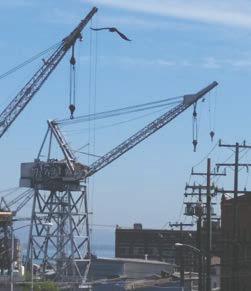

The UCSF Medical Center at Mission Bay is on MUNI T- line and the 55 and 22 bus lines. If you drive, please park at no charge in the Medical Center surface lot. Remember to get a prepaid parking voucher at the end of the meeting
For more information, contact: Michele Davis at 415-476-3024 Michele.Davis@ucsf.edu
If you would like to be on our email notification list, please email community@cgr.ucsf.edu, specifying the campus site(s) of interest: Parnassus, Mission Bay, Mount Zion, Zuckerberg San Francisco General Hospital
UCSF Medical Center Oberndorf Auditorium, Mission Bay 1855 Fourth Street (enter from Mariposa) Monday, April 10, 2017 at 6:30 pm
You are invited to a UCSF community meeting to learn about and provide feedback on the proposed building design for UCSF’s Minnesota Graduate Student/Trainee Housing at 566, 590 and 600 Minnesota Street
UCSF is proposing to develop housing for graduate students and trainees along with their spouses or partners (no children). The project will comprise two structures on Minnesota Street, one to the north of 18th Street and one to the south, and each building will comply with local zoning and height restrictions. Of the 130 off-street parking spaces included in the project, approximately 30 spaces would be set aside for vehicle-share services, and electric vehicle charging stations would be provided. Planned on-site amenities would include bike parking, social space, community rooms, laundry, as well as a corner market to serve the project residents and the Dogpatch neighborhood. The proposed project is anticipated to begin construction in 2017 and be occupied by summer 2019.
UCSF fully subscribes to the Americans with Disabilities Act. If at any time you feel you have a need for accommodation, please contact UCSF Community & Government Relations at 415-476-3206 or community@cgr.ucsf.edu with your suggested accommodation
In the 2003 movie, Calendar Girls, starring Helen Mirren, a group of well-aged women turned themselves into “pin-up girls.” When Potrero Hill Neighborhood House staffer, Jean Crosby, discovered that Senior Lunch program participant Lorys Crisafulli had experience creating similar calendars, she suggested a reprise of the effort. With her 90th birthday looming, Crisafulli agreed to create a 2017 calendar, using as models “the ladies who lunch” at the Nabe.
A dozen calendar girls were selected. Crosby secured more than $11,000 in advertisements and contributions to cover production costs, including from Hilliard Architects and Tim Parker Studios. Damien Alvarez Design volunteered its time and talent to photograph the women and produce the calendar. Hill historian Peter Linenthal also made photographs.
“We had a grand time in the photo sessions,” Crisafulli, “Miss January,” recalled, who was responsible for the calendar’s “clever captions.”
“These were really bonding experiences,” reported “Miss July,” Dorene Cotter.
The calendar was first sold for $15 at the Potrero Hill Fall Festival last October, the booth staffed by Crisafulli,
with assistance from other calendar “honeys.” A two-month “door-todoor” marketing effort followed, with Christopher’s Books, Chiotras, The Ramp Restaurant, Farley’s, and the Nabe vending copies. Crisafulli – in a red sequined baseball cap or black fedora – Cotter, and Sally Taylor –attired in a coonskin cap – became neighborhood fixtures.
The effort raised $7,500, with the funds dedicated to supporting Potrero Hill residents’ post-high school academic, vocational or technical education, including books and other materials. Twelve $500 scholarships are on offer. Applications are available at the Nabe, with a May 1 deadline. Winners will be announced at the May 25, 2017 graduation celebration at the Nabe.
“We got a lot more laughs than we sold calendars,” Lorys admitted. “But we had a great time doing it, too. And we met loads of interesting people along the way.”
Copies of the calendar, on sale for $5, are available at the Nabe. For more information about the scholarship: 415.826.8080
A meeting of the Board of Directors of the Economic Opportunity Council of San Francisco, Inc. has been called by Board President Reverend Arnold Townsend...
Wednesday, April 26, 2017 – 6:00PM
Economic Opportunity Council of San Francisco, Inc. 1426 Fillmore Street, Suite # 301 San Francisco, CA 94115
The general purpose of the meeting is to elect new leadership to the board of directors, welcome new members from the community to the board and to discuss the ongoing operations, finances and direction of the Agency. The Economic Opportunity Council of San Francisco, Inc. exists to empower San Francisco’s most economically disenfranchised residents. Among our programs are Home Energy Assistance, Weatherization, Corridor Ambassadors, Potrero Hill Community Center, Earned Income Tax education and awareness, Computer Resource Center and others.
Light refreshments will be served and community members are encouraged to attend. If you need any further information, please feel free to email Elena Huezo at e.huezo@eocsf.org


Potrero Dogpatch Merchant’s Association meets the second Tuesday of each month at 10 a.m. at Goat Hill Pizza, corner of Connecticut and 18th streets. Website: www.potrerodogpatch.com . Call 415.341.8949. Next meeting: April 11th.
Starr King Open Space meets for monthly Stewardship Day the second Saturday of each month from 9:30 a.m. to 12:30 p.m. at Starr King Open Space, corner of Carolina St. and 23rd St. Come out and meet your neighbors, be a community steward, enjoy the natural grassland habitat, see spectacular views, and celebrate our beautiful neighborhood open space. Everyone is welcome. Find out more at www.starrkingopenspace. org or facebook.com/StarrKingOpenSpace
SOMA Rotary Club meets the second and fourth Thursday of the month at Mission Rock Resort, 817 Terry Francois Blvd. We meet at 6 p.m. for a mixer and 7 p.m. for a dinner meeting. We provide community service to the Mission Bay, Potrero, and Bayview communities. The focus is on providing services for the under-served of our community. The website is located at: www.meetup.com/Mission-Bay-Rotary-Club. For more information contact Nine at: n.ladow@comcast.net
Potrero Hill Garden Club usually meets the last Sunday of the month at 11 a.m. for a potluck in a local home or garden. We occasionally visit gardens such as Ruth Bancroft, Yerba Buena, Cornerstone, Filoli, and the rooftop garden at the Fairmont. We discuss gardening appropriate for Potrero Hill’s microclimates, and often have speakers on subjects such as drought, wind, shade, pests, and even flower arranging. For details, please contact us at Gardener@PotreroHillGardenClub.org
Dogpatch & Northwest Potrero Hill Green Benefit District General Board Meeting. Working together to green-up, clean-up and beautify public spaces in Dogpatch and NW Potrero Hill. Board of Directors meeting. Wednesday April 19th. Free. 6:30 to 8:00 PM. Tivoli Room @ UCSF, 654 Minnesota Street. http://www.greenbenefit.org
My husband and I grew up in suburbs, with tree-lined streets, quiet neighborhoods and very, very homogenous populations. Becoming parents has prompted us to engage in ongoing reflection over the type of upbringing we want to give our daughters. As a biracial family in today’s tumultuous political climate, with a President who built a platform on fear and intolerance of diversity, we want to ensure, now more than ever, that our children are raised with exposure to a wide variety of people, where heterogeneity is not only accepted, but supported and celebrated.
My husband and I love walking up the street and passing the playground, where we see children and families of all different backgrounds, colors, and sizes. We love hearing my two-year-old daughter seamlessly transition between English and Spanish when speaking to a new friend she met at the park. And we love that we can experience the beach, hiking, the farmer’s market, a new food truck park, a baseball game or a museum, all in one day living in the City.
A recent Scientific American article reported that diversity, being around people who are different, makes us more creative, diligent and hardworking. The unique opportunities that San Francisco offers our children every
day are shaping the people they are and will become in the future. It’s this diversity, and access to a wide array of experiences, that they’ll carry with them throughout their life, ultimately helping them both personally and professionally.
We’ve been so happy to see our toddler daughter, and now our newborn, thrive in the City, and look forward to raising them in an area where the future is bright and prospects are endless.
Oriana Branon is a 10-year resident of San Francisco, a public relations professional, and a proud mom. She lives in Potrero Hill with her husband Trevor and two daughters, Gabi and Mica.
a day, said she’d been writing down license plates numbers and taking photos to email to Lyft, but that isn’t how she wants to spend her time. “I don’t want to punish those drivers. I just don’t want them to block my driveway,” she said.
“You are very passive,” Cohen told the Lyft representatives, suggesting that they needed to be more proactive in dealing with problem drivers. She called their efforts “nice gestures,” but admonished, “You don’t want to own it. You need to have one or two people to patrol and make sure their drivers are in compliance with the law.”
Rather than better management of the situation, attendees wanted a reduction in the number of Lyft vehicles visiting The Hub. “You don’t fit here,” said Roz Foster.
Kansas Street SAFE Neighborhood Association, suggested Lyft limit the site’s activities to just inspections for new drivers. According to the company’s calculations, that’d amount to just 30 cars per month. Vaswani proposed Lyft create a satellite parking site, from which drivers could take a shuttle to The Hub.
O’Connor’s association advocated for all-way stop signs on Kansas and 26th streets, supported by Lyft. Those signals will be installed this month.
meeting participants that he’s sent officers to patrol the site, with poor results. According to Sergeant John Bragagnolo of SFPD’s Motorcycle Unit, on a given day there could be 30 problem drivers. “I might catch one but if it’s not that one, it’s the other 29,” he said. The fact that different drivers arrive daily makes it difficult to change behavior.
Neighbors expressed unhappiness about having to police the area themselves. Sharon McGill, who claimed her driveway gets blocked five times
While taxicab companies operating in the City have their own parking lots located in industrial districts, San Francisco’s Planning Code doesn’t address new ridesharing business models, like Lyft. According to Cohen and SFMTA Planning Director Sarah Jones, an assortment of municipal officials, including the City Attorney’s Office, have investigated the issue. The Hub is zoned for light industrial use, Cohen explained, and Lyft can legally operate there. “Zoning laws simply have not caught up with rapid changes in the City,” she said.
Jones added that Lyft’s permit is for general office use. There was no requirement for additional evaluation of the company’s activities to secure it, although she called the 150 cars the building draws daily a “gray area.”
Ray O’Connor, who captains the
At the end of the meeting, Gandhi promised he’d establish a hotline where residents can call in, rather than email, complaints to get a response quickly. He also said he’d look into having employees regularly monitor two blocks of Kansas Street, from 26th to 24th streets, and brainstorm different ways of educating drivers to follow rules.
“It’s going to take give and take on everyone’s part,” ended Cohen. “I just worry about an accident.”
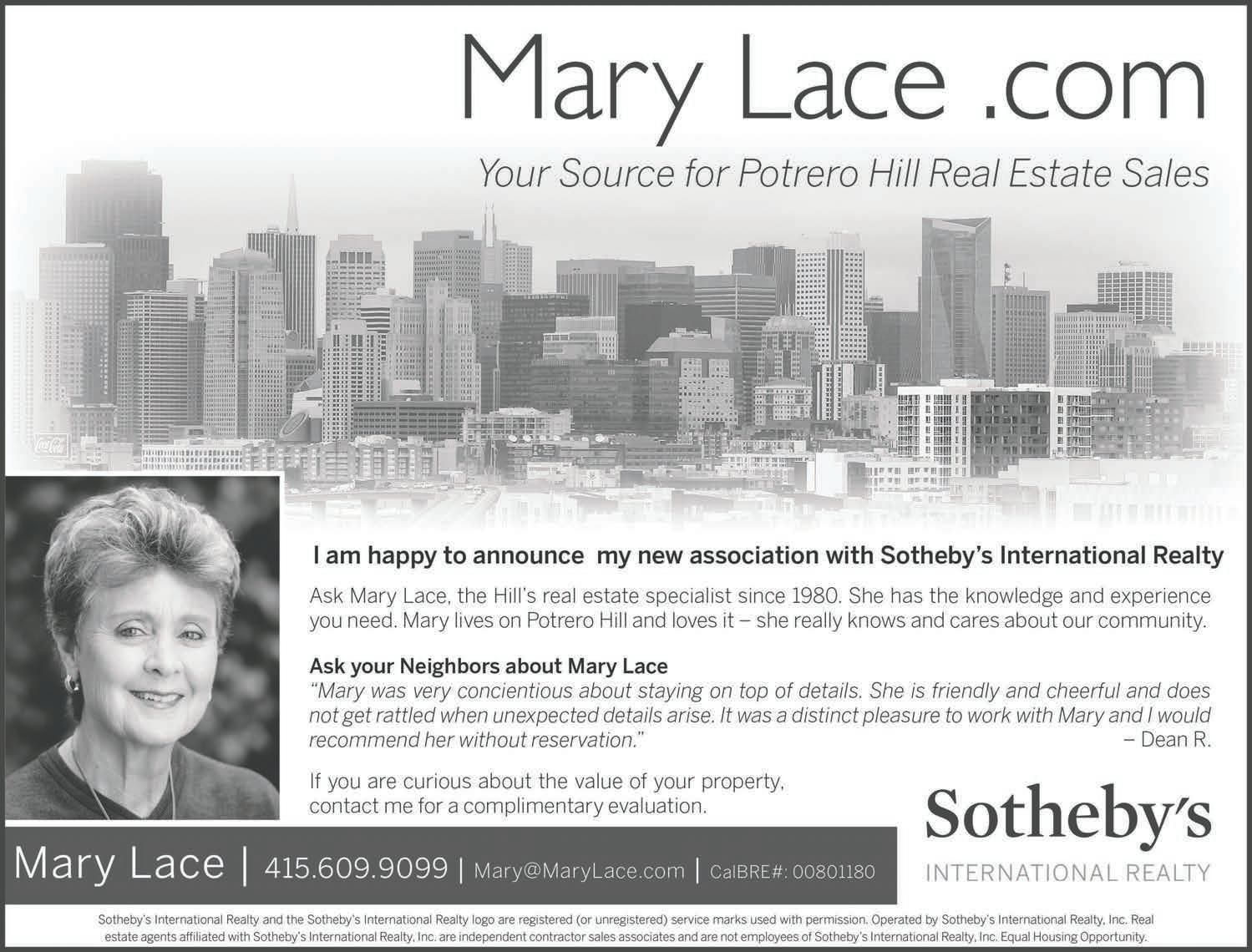













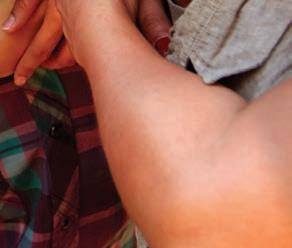



The UCSF Medical Center at Mission Bay is on MUNI T- line and the 55 and 22 bus lines. If you drive, please park at no charge in the Medical Center surface lot. Remember to get a prepaid parking voucher at the end of the meeting
If you would like to be on our email notification list, please email community@cgr.ucsf.edu, specifying the campus site(s) of interest: Parnassus, Mission Bay, Mount Zion, San Francisco General Hospital. UCSF fully subscribes to the Americans with Disabilities Act. If at any time you feel you have a need for accommodation, please contact UCSF Community & Government Relations at 415-476-3206 or community@cgr.ucsf.edu with your suggested accommodation.
For more information, contact:
Michele Davis at 415-476-3024
Michele.Davis@ucsf.edu
UCSF Medical Center Mission Bay, Oberndorf Auditorium 1855 Fourth Street (enter from Mariposa)
Wednesday, April 12, 2017 at 6:30 pm
You are invited to a community meeting to learn about and provide feedback on the proposed design for a UCSF Child, Teen and Family Center and Department of Psychiatry building at 2130 Third Street (along 18th Street between Third & Tennessee streets).
We have been in discussions with neighbors planning for this outpatient center that will provide a beautiful state-of-the-art setting for superior, family-focused mental health care, informed by the latest research in psychiatry and neuroscience.
At this meeting, UCSF will share information about our proposed design for a building that will provide services to the community, the Bay Area and beyond, while substantially improving our understanding of illness prevention and treatment of children, adolescents and adults. This project includes clinical research, education and administrative functions, addressing a critical need for research and training to advance the prevention and treatment of mental illness, including aging-related diseases. We look forward to our meeting and getting your invaluable feedback
For additional project information, please goto www.ucsf.edu/cgr and click on “Child, Teen and Family Center” at the bottom of the page.





For 47 years, The Potrero View has offered news about important neighborhood goings-on, including what’s happening in our schools, with local merchants, families, parks, and cherished personalities. We’ve even occasionally broken larger stories, about the closure of the Hunters Point and Potrero power plants, new parking regulations, and land use changes. We’re still here, even while the San Francisco Bay Guardian and other publications aren’t, and the San Francisco Examiner is no longer a daily.
The View will only survive into the future with your help Which is why we’re asking you to donate generously to the paper. Please take this opportunity to show your appreciation for community news by doing one or more of the following:
SUBSCRIBE! For $48 you’ll receive the paper every month in your mail box. How exciting!
DONATE $68, and receive a copy of The Daddy Handbook, by View publisher Steven J. Moss, a perfect gift for fathers and would-be dads!
DONATE $88, and receive a “life and death bundle,” The Daddy Handbook, a celebration of fatherhood, and Last Things: A Graphic Memoir of ALS, a gripping and deeply personal account of how Marissa Moss grappled with the death of her beloved husband.
DONATE $100, and receive all of the above plus our deep gratitude!

YES! I love the View, and would be delighted to help support it with my gift of: $48 $68 $88 $100 Some other affordable amount $
Please send: my subscription The Daddy Handbook Last Things Your Love to:
FULL NAME
ADDRESS
CITY STATE ZIP CODE
EMAIL ADDRESS
Enclosed is my check. (Please send, along with this form, to: The Potrero View, 1459 18th Street, Number 214, San Francisco, California 94107)
I am sending my gift via PayPal (office@potreroview.net).
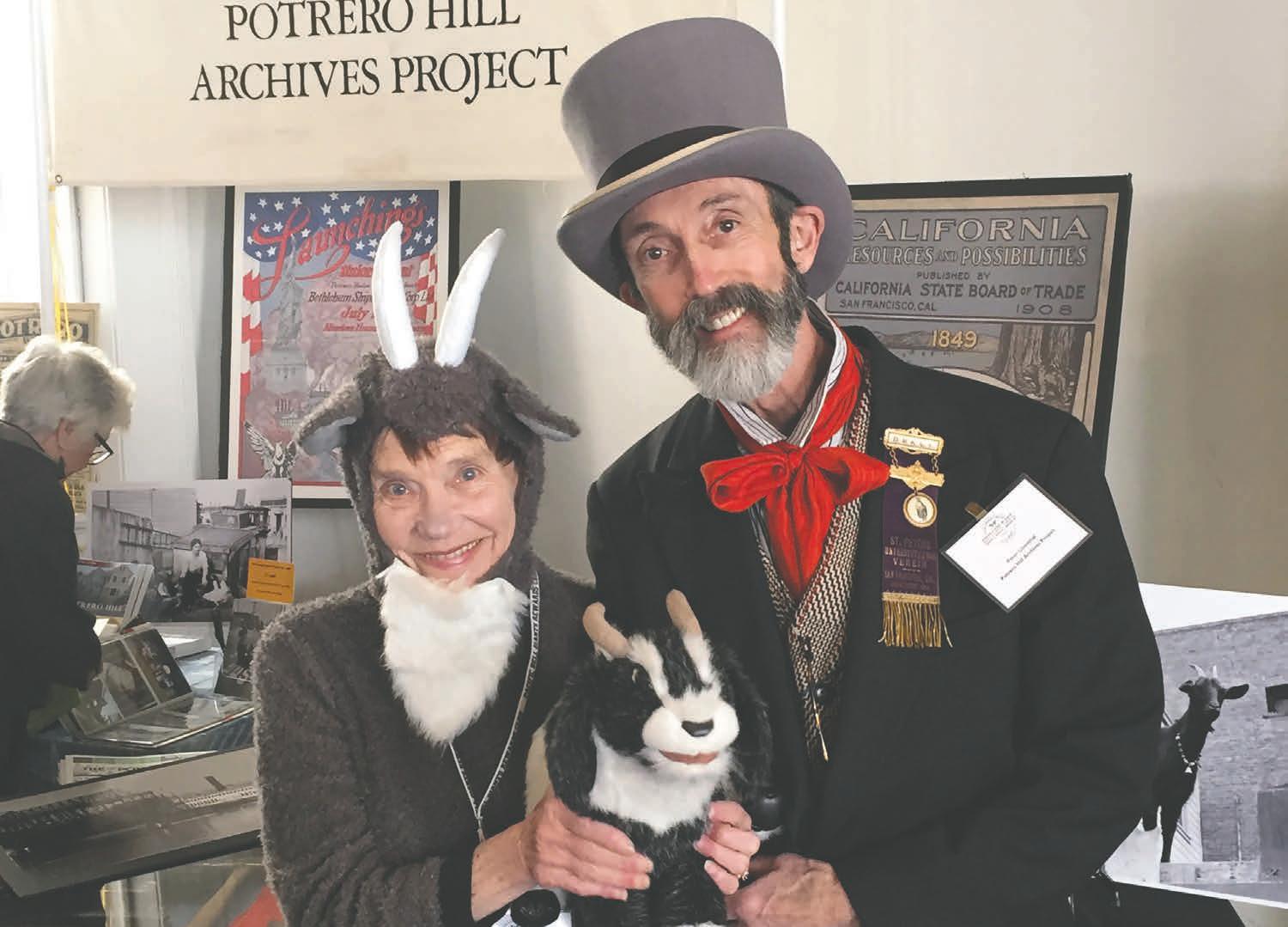
Next Meeting: Monday, April 24, 6:30pm
UCSF at Mission Bay, Genentech Hall, Room N-114



The Dogpatch Community Task Force has been formed to identify and discuss potential impacts and solutions of UCSF’s proposed development in the Dogpatch neighborhood. The group is composed of Dogpatch and Potrero Hill neighbors and merchants, city staff and UCSF staff.
UCSF is currently planning two developments in Dogpatch that will be the focus of the discussion:
• Graduate student and trainee housing at 560, 590 and 600 Minnesota Street
• Department of Psychiatry Child, Teen and Family Center at 2130 Third Street


•
•
For more information, contact Michele Davis at Michele.Davis@ucsf.edu, 415-476-3024.
To be on our notification list, email community@cgr.ucsf.edu, specifying the campus site(s) of interest: Parnassus, Mission Bay, Mount Zion, Zuckerberg San Francisco General Hospital. UCSF fully subscribes to the Americans with Disabilities Act. If at any time you feel you have a need for accommodation, please contact UCSF Community and Government Relations at 415-476-3206 or community@cgr.ucsf.edu with your suggested accommodation.
UCSF Mission Bay Campus is accessible using the MUNI T-Third light rail line and bus #55. If you need to drive, please park
3rd St. Garage along 4th Street, one block north of 16th Street. Parking vouchers will be provided.

ment in public transit.
One has to dig deep into the 2,000page Draft EIR to understand exactly how much traffic Pier 70 will generate. Buried in an appendix is a traffic study done under the “Level of Service” methodology, which shows that 30 intersections will operate at “Level F” – near constant gridlock – as a direct and dire result of the project. Whether one relies on a car or not, our quality of life will certainly suffer under these conditions.
Forest City proposes a band-aid solution to San Francisco Municipal Transportation Agency’s abysmal failure to provide Dogpatch and Potrero
Hill adequate public transit. While Pier 70’s planned onsite walkways and bike paths should be encouraged, they won’t serve everyone’s needs. Car- and ride-sharing reduce parking demand, but discourage public transportation use and make traffic worse. Along with other nearby developments, Pier 70 will rely heavily on an unregulated network of private shuttles, resulting in a patchwork system. These private fixes are neither efficient nor sustainable over the long-term. We need more buses, more trains and additional lines to connect east and west. This is a City problem, one that won’t be solved without a comprehensive public solution.

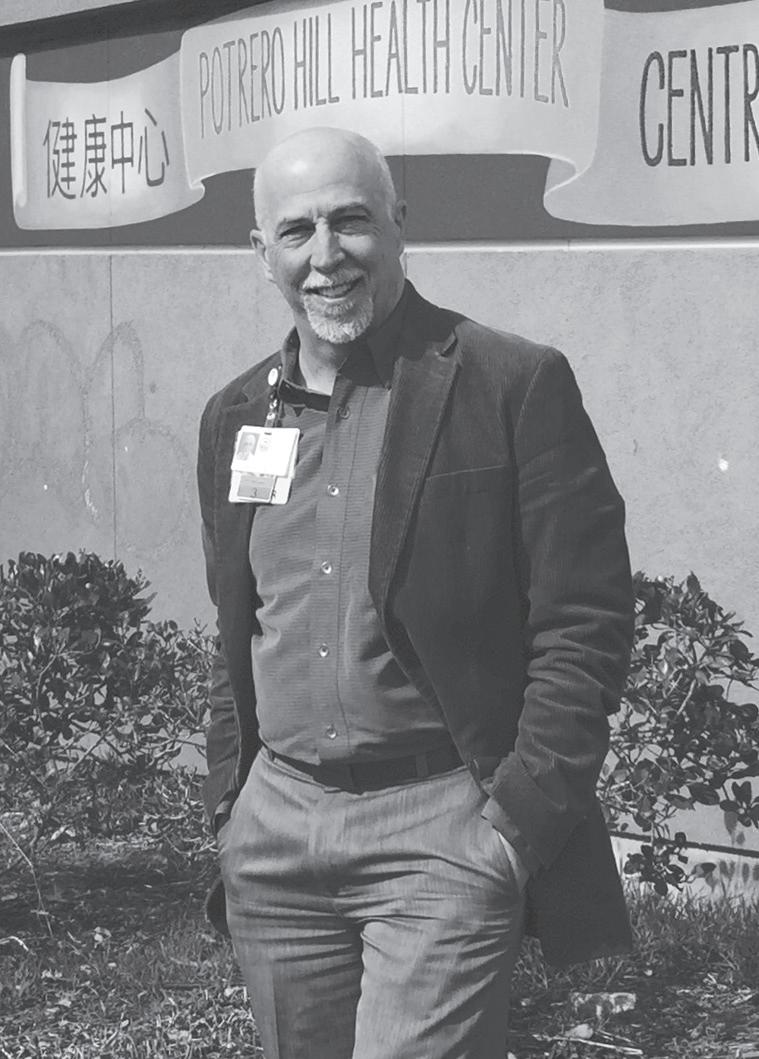





You
You
You understand the tax benefits.





Getting a home ready for sale doesn’t have to be difficult or expensive. There are several simple ways you can add value inexpensively:
MAKE IT SHINE—There is nothing more important than ensuring your home is clean.
LIGHTEN AND BRIGHTEN—If it is time to repaint, consider lighter colors that will make your home brighter and feel more spacious.
OUT WITH THE OLD—It is easy to accumulate clutter even after just a few years. Donating or discarding unneeded items can make a home feel more spacious—and make your future move easier.
DON’T FORGET SMALL THINGS WITH BIG IMPACTS—Simple steps like painting the garage floor or planting bright flowers near your home’s entrance are easy and inexpensive ways to make a home more welcoming and tidy.
If you’d like a free report on the value of your home, call Tim Johnson at 415-710-9000.
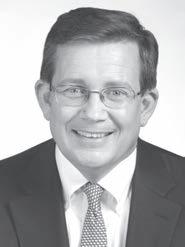
Tim Johnson
415.710.9000
tim@timjohnsonSF.com
www.timjohnsonSF.com
Lic. #01476421
“So,” said Nash. “Now what?”
They’d gone to Nash and Justin’s flat to outfit themselves for the dig, everyone except Stephanie bolstering their resolve by sucking on a bong shaped like a lizard. Justin had rifled through his collection of Burning Man cum camping gear, assigning costumes and equipment. He was wearing a full length emerald-colored gown with faux fur collar, accented with pearls and hiking boots, holding a heavy duty bolt cutter. Nash, gripping a folding shovel, had on cargo pants, a brown camouflage t-shirt, a bright blue handkerchief tied around his neck, and night vision goggles. Jordan sported a plaid skirt, high knee socks, a white furry vest, and a tire iron. Stephanie had balked, reluctantly accepting a Papal tiara along with a Leatherman. All four sported headlamps.
“I’m freezing my balls off,” said Jordan, hopping back and forth. “This getup sucks; you could’ve at least given me wool underwear.”
“That goes with the nun costume, which you refused to wear,” retorted Justin. “And quiet down.”
Chester’s property was situated on a corner, small apartment buildings tight against it on two sides, protected by an eight-foot high chain link fence interlaced with thin redwood slats. A double-wide curb fronted a firmly closed electronic gate. It was well after midnight. The street was deserted; nearby houses quiet and unlit.
“We could have climbed it,” said Stephanie, eyeing the fence, illuminated by a street light. “But, probably not with those dresses on. There’s an absence of forward thinking going on here. Or really, of any thought at all.”
“
Au contraire, mon not enemy,” said Justin. “We have everything we need. Nash, deploy night vision, find us a way in.”
“Uh, okay,” said Nash. He adjusted the goggles, turned them on, and scanned the fence, walking along the perimeter. Jordan bounced, trying to stay warm. Stephanie leaned against a parked car, arms folded across her chest. Justin stood, hands on hips, watching Nash.
“Find anything,” Justin asked. “A weakness? A hole?”
“Nope,” said Nash. “It’s a great looking fence. We’re not getting in. Time to go home.”
“Oh for the love of Harvey Milk!” exclaimed Justin, turning on his headlamp. “It obviously takes a man to do a man’s job!” He strode around the corner, to where the fence ended with a pole mounted a few inches from a tired-looking three-flat Victorian, and started snipping links with the bolt cutter. The three gathered around him.
“Why do you have that thing, anyways,” whispered Stephanie. “I mean, who keeps a bolt cutter?”
“Long story,” said Justin, “involving handcuffs, a similar fence, very short shorts, no shirt, and Dolores Park. Anyways, here we are.” He pried open a strip of links. “Headlamps on! Ladies, first,” he said to Stephanie, bowing.
“Fine,” she said, stepping into the property, followed by Jordan, Nash, and
Justin, who peeled the strip back into place. They stood in front of a large area crowded with tall plants, pots as big as tires, and life size garden statues, adjacent to a covered space, filled with similar bits, that was next to a modestsized building.
Jordan looked at his iPhone. “The footprint of the original building should be this way.” He weaved through the outside nursery towards the structure, the trio following single file, their lights dancing on the foliage, briefly illuminating concrete deer, wooden tortoises, and a mermaid fountain trickling water. Stopping at the back entrance, Jordan walked slowly along its exterior. At a corner he squatted next to a pile of branches and debris. “Help me with this.” Following Jordan’s lead, Justin and Nash pulled at the pile, revealing a set of concrete stairs that led to a small vestibule and a windowed door that’d once been painted yellow.
Justin whistled softly, and stepped down the stairs, pushing aside clumps of twigs, leaves, and bits of plastic garbage. He cupped his hands, peered through the window, jiggled the doorknob. “Tire iron,” he said, reaching an arm towards Jordan. The dry wood gave way easily; Justin pushed the door forward, shifted aside rubble, and stepped into a large high-ceiling basement, the rest of the group trailing behind.
“Phew,” said Nash. “Smells like burnt death.”
“That’s what we’re looking for,” said Stephanie, softly.
The light from their headlamps swept the space. Half of it was filled with sinking stacks of cardboard boxes, some had toppled, all layered with a sticky grey-ash residue that emitted a microwaved plastic odor. Justin jolted when his headlamp lit up what looked like a melting face, which turned out to be a rubber monster mask set on a stick. Nash bent down and riffled through a few of the boxes, finding a chipped blue ceramic ashtray half-filled with loose coins, a toy accordion in mint condition, photograph albums, books, a drivers’ license. “Todd Cox, expires October 27, 1987. What is all this stuff? It’s seems to be from before the fire.”
“Shells and pebbles left behind from the high tide of the AIDS epidemic,” said Jordan. “I listened to some podcasts about multi-unit apartment buildings occupied by clusters of gay guys. During the 1970s and ‘80s people fled their homes in Ohio, or Nebraska, searching for a place where they could be themselves. Kind of like me, except I’m more of an economic immigrant, looking for a place I can make big bucks. Their relatives disowned them; not like mine, who definitely plan on cashing in when I hit it big. When HIV swept through and they died, no one was around to take their stuff. This must be where they stored unclaimed items when they cleaned out tenants’ apartments here.” He poked through a box, pulling out a small metal globe, which rattled in his hand.
“It’s like a diorama of death,” said Nash.
“A tomb of Todd-in-common,” quipped Jordan.
“Okay, guys, this isn’t what we’re looking for. Can we like, move on, so we
can go home?” said Stephanie.
“Over here,” called Justin, from the basement’s far corner. “I think this is what we want,” he said, as they crowded around him.
In front of them was a mess of large objects, whose contours became clearer as the four rays of light darted over them. Tattered ribbons of yellow police “don’t cross” tape snaked throughout. A few washers and dryers, askew, a v-shaped line of dark smoke outlined above them. Piles of plaster, scorched planks, and ruined light fixtures intermixed with torn fabric. Several charred wooden beams, perhaps a dozen feet in length, lay like Pixy Stixs, their lower ends slow-crushing shadowy piles of laundry baskets, pillows regurgitating clothes, old chairs, indistinguishable blobs. The burnt smell was fierce. Justin beamed his light at the ceiling above the chaos; it was rudely patched and spackled. “My guess is that if anything, or anyone, fell through to this level they ended up here.”
“Yeah,” said Nash, holding up his small shovel, which he’d unfolded in preparation. “And we’re not finding it, not by ourselves. Not tonight, not any night.”
“You’re probably right,” said Jordan.
“Wait a sec,” said Stephanie, who had pointed her light at some rubble at the far end of the destroyed space. “That could be promising.”
“What,” said Justin, walking towards her.
She gestured towards the pile, now illuminated by multiple shafts of light. Resting on a battered rectangle
of white decorative tin, the type used for paneling in Victorian homes, was a dust-caked pair of aviator-style eyeglasses. “Jordan, can you bring up that photograph of John Randall?” Stephanie asked.
Jordan tapped on his phone, and held up an image of a Black man, in his 60s, wearing the same type of glasses. “I think we have a match!”
“Maybe,” said Stephanie, moving towards the pile. “Let’s find out.” She bent-walked toward the glasses, choosing her steps carefully.
As she reached for them her Papal tiara knocked against a beam that angled above. The hat fell to the floor; a cloud of dark dust billowed upwards. Stephanie covered her mouth with her hands, violently coughing, bending down so that one of her knees pressed against a mound of debris, which puffed more particulate matter. The beam made a short screech, shifting a half inch downwards.
“Yikes!” yelped Nash, who pulled his handkerchief over his mouth and goggles over his eyes, and cat-walked to Stephanie, avoiding the larger wreckage.
“I can’t see them!” Jordan yelped, gripping Justin’s bicep. The beam screeched again.
Nash emerged from the dust, clutching Stephanie in front of him, who continued to fiercely hack. “Let’s get out of here!” he croaked. The four scrambled towards the exit, knocking over boxes and other objects, trailing a cloud of sticky powder, like a vehicle driving across a loose dirt road.
GOLD continues on page 26
For Rent
ONE-PLUS BEDROOM HOME FOR
RENT on Wisconsin and 20th streets. Features two-car garage, loft, office space with bathroom, backyard access, washer/ dryer. Available April 1; $3,750. editor@ potreroview.net; 415.643.9578.
Housekeeping
CLEANING PROFESSIONAL 28 years experience. Apartments, homes or offices and apartment buildings. Roger Miller 415-794-4411 References upon request.
Photography Consultant
Experienced photo technician, specializing in in-home/studio archiving and file management. Call 826.266.7587, for Sam.
Subscribe to the View!
Annual Subscription: $48. Contact us at: 415.643.9578 editor @ potreroview.net advertising @ potreroview.net
UPDATE, POST, & PAY ONLINE
Visit www.potreroview.net
COST
$25
GOLD from page 25
They stumbled into the night, a chorus of coughs. Justin wedged the door shut, the dust spreading through the cracks around them.
“Follow me!” said Justin, leading the group to the gap in the fence. The dust seemed to follow them, mixing with a thickening fog as if greeting an old friend.
On the sidewalk, Stephanie held on to Nash, her and the others’ coughs subsiding.
“You all look like you came out of a coal mine,” panted Jordan.
“Yes,” wheezed Justin, “You too.”
“That didn’t work out so well,” gasped Stephanie.
“I dunno,” said Nash. He reached into his pants pocket, and held up the eyeglasses. “At least we got this.”
Each month the View publishes a chapter from Gold , a serialized tale of politics, capitalism, and corruption in San Francisco. Previous chapters can be found on the paper’s website, www.potreroview.net. Advertisers or supporters interested in sponsoring future installations, or publishing the final manuscript, should contact editor@potreroview.net.
CELEBRATE YOUR CHILD’S MILESTONES: The View is pleased to publish photographs and captions feting birthdays, graduations, sports achievements and the like. Send yours to editor@potreroview.net
FREELANCE WRITERS: The View is looking for writers, with fee-based compensation provided. Contact: editor@potreroview.net
YOUR CONTRIBUTIONS WELCOME: Donations of any size are appreciated to support your neighborhood newspaper. Send checks to:
The Potrero View 1459 18th Street, Number 214 San Francisco, California 94107
sidetracked by what Trump says or does about the money he’s making. It’s more important to watch the under-theradar evil his minions are doing. People should keep their eyes open, speak out against harmful policy decisions, and, whenever they see their legislator take a stand against real injustice, thank her for doing that.”
Last month, Modern Appealing Clothing, which has an outlet in Dogpatch, sued Ivanka Trump’s company over unfair competition. The class action lawsuit, filed in San Francisco Superior Court, claims that Ivanka
City and County of San Francisco Outreach Advertising
April 2017
The Airport Commission has commenced the following Request for Proposals (RFP) / Request for Bids (RFB) process:
International Terminal Boarding Areas A and G Newsstand and Specialty Retail Concession Leases.
The RFP includes 3 Newsstand and 2 Specialty Retail Leases.
Trump’s brand got a boost from Donald Trump’s tweets blasting Nordstrom for dropping her line, and from Kellyanne Conway telling people to “go buy Ivanka’s stuff” during an interview with Fox News. Despite Nordstrom and other retailers, including Sears and Kmart, dropping Trump’s line, Courthouse News reports the brand’s sales grew 346 percent between January and February. The lawsuit seeks unspecified damages on behalf of women’s clothing retailers operating in California since January, and for an order preventing the Ivanka Trump brand from being sold in the state.
The proposed minimum annual financial offers range from $210,000.00 to $1,200,000.00. Rent shall be the higher of the Minimum Annual Guarantee (“MAG”) or the sum of the percentage rent structured as follows: 12% of Gross Revenues achieved up to and including $500,000.00; plus 14% of Gross Revenues achieved from $500,000.01 up to and including $1,000,000.00; plus16% of Gross Revenues achieved over $1,000,000.00. The proposed terms are all seven years.
International Terminal Duty Free and Luxury Stores
The RFP is for 10 Duty Free and Luxury Stores locations in the International Terminal, and one location in Terminal 1. The concepts sought are duty free core category shops and high-end luxury boutiques. The proposed MAG is $42,000,000.00, and the Minimum Acceptable Percentage Rent Offer is Thirty Percent (30%) of Gross Revenues. The proposed term is fourteen years.
International Terminal “A” Food Hall and Café Concession Lease
The MAG for the first year of the lease would be $495,000.00. The base rent would be the higher of the MAG or the sum of the percentage rent structured as follows: 6% of Gross Revenues achieved up to and including $2,500,000.00; plus 8% of Gross Revenues achieved from $2,500,000.01 up to and including $3,000,000.00; plus 10% of Gross Revenues achieved over $3,000,000.00. The proposed term is ten years with two one-year options.
International Terminal “A” Historic Restaurant Concession Lease
The MAG for the first year of the lease would be $330,000.00. The base rent would be the higher of the MAG or the sum of the percentage rent structured as follows: 8% of Gross Revenues achieved up to and including $1,000,000.00; plus 10% of Gross Revenues achieved from $1,000,000.01 up to and including $1,500,000.00; plus 12% of Gross Revenues achieved over $1,500,000.00. The proposed term is ten years with two one-year options.
International Terminal “A” Coffee Kiosk Concession Lease
The MAG for the first year of the lease would be $165,000.00. The base rent would be the higher of the MAG or the sum of the percentage rent structured as follows: 6% of Gross Revenues achieved up to and including $1,000,000.00; plus 8% of Gross Revenues achieved from $1,000,000.01 up to and including $1,500,000.00; plus 10% of Gross Revenues achieved over $1,500,000.00. The proposed term is seven years with two one-year options.
Please visit our website at www.flysfo.com/business-at-sfo/current-opportunities
The Board of Supervisors are accepting applications for a vacancy on the Police Commission
Interested applicants may apply at http://www.sfbos.org/vacancy_application or from the Rules Committee Clerk, 1 Dr. Carlton B. Goodlett Place, Room 244, San Francisco, CA 94102-4689 or call 415-554-5184.
Mayor’s Office of Housing and Community Development
Notice of Public Hearing and Availability of Draft 2017-2018 Action Plan, Including Preliminary Funding Recommendations
The Draft 2017-2018 Action Plan, which includes preliminary funding recommendations for the CDBG, ESG, HOME and HOPWA programs, will be available for public review and comment from March 23, 2017 through April 21, 2017. A public hearing to receive comments on the Draft 2017-2018 Action Plan is scheduled for Tuesday, March 28, 2017 at 5:00 PM at 1 South Van Ness Avenue, 2nd Floor Atrium Conference Room. Please visit www.sfmohcd.org or call 415-701-5500.





“JCHS showed me the power of building community by creating a sense of belonging, support and connection—a sense of home. ”


